Text
Top 10 Games of 2019
This was an extremely good year for games. I don’t know if I played as many that will stick with me as I did last year, but the ones on the bottom half of this list in particular constitute some of my favorite games of the decade, and probably all-time. If I’ve got a gaming-related resolution for next year, it’s to put my playtime into supporting even smaller indie devs. My absolute favorite experiences in games this year came from seemingly out of nowhere games from teams I’ve previously never heard of before. That said, there are some big games coming up in spring I doubt I’ll be able to keep myself away from. Some quick notes/shoutouts before I get started:
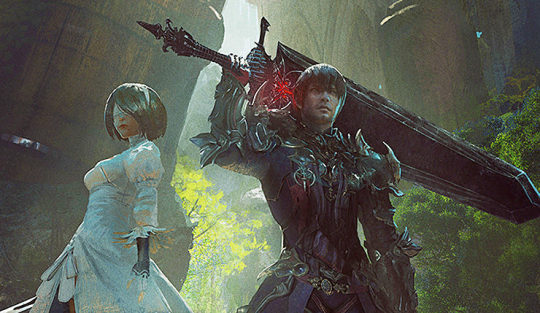
-The game I put maybe the most time into this year was Final Fantasy XIV: A Realm Reborn. I finally made the plunge into neverending FF MMO content, and I’m as happy as I am overwhelmed. This was a big year for the game, between the release of the Shadowbringers expansion and the Nier: Automata raid, and it very well may have made it onto my list if I had managed to actually get to any of it. At the time of this writing, though, I’ve only just finished 2015’s Heavensward, so I’ve got...a long way to go.
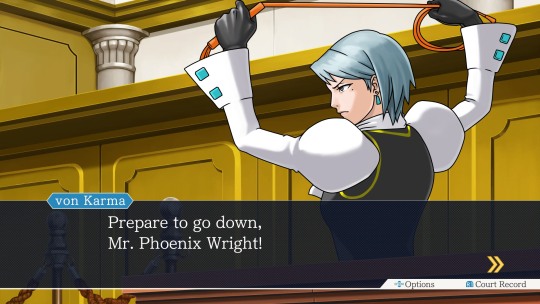
-One quick shoutout to the Phoenix Wright: Ace Attorney Trilogy that came out on Switch this year, a remaster of some DS classics I never played. An absolutely delightful visual novel series that I fell in love with throughout this year.
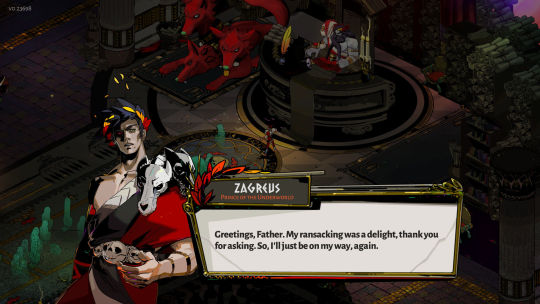

-I originally included a couple games currently in early access that I’ve enjoyed immensely. I removed them not because of arbitrary rules about what technically “came out” this year, but just to make room for some other games I liked, out of the assumption that I’ll still love these games in their 1.0 formats when they’re released next year to include them on my 2020 list. So shoutout to Hades, probably the best rogue-like/lite/whatever I’ve ever played, and Spin Rhythm XD, which reignited my love for rhythm games.
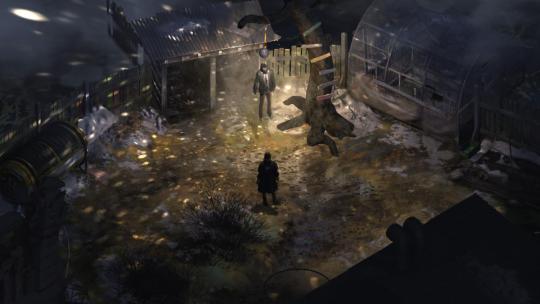
-Disco Elysium isn’t on this list, because I’ve played about an hour of it and haven’t yet been hooked by it. But I’ve heard enough about it to be convinced that it is 1000% a game for me and something I need to get to immediately. They shouted out Marx and Engels at the Game Awards! They look so cool! I want to be their friend! And hopefully, a few weeks from now, I’ll desperately want to redact this list to squeeze this game somewhere in here.
Alright, he’s the actual list:
10. Amid Evil
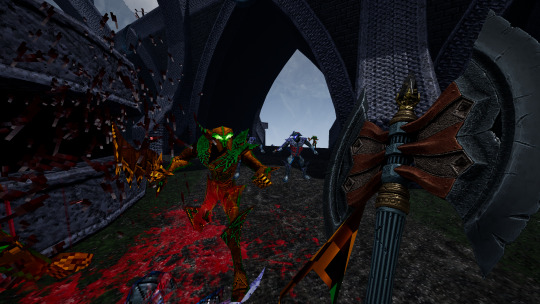
The 90’s FPS renaissance continues! As opposed to last year’s Dusk, a game I adored, this one takes its cues less from Quake and more from Heretic/Hexen, placing a greater emphasis on melee combat and magic-fuelled projectiles than more traditional weapons. Also, rather than that game’s intentionally ugly aesthetic, this one opts for graphics that at times feel lush, detailed, and pretty, while still probably mostly fitting the description of lo-fi. In fact, they just added RTX to the game, something I’m extremely curious to check out. This game continued to fuel my excitement about the possibilities of embracing out-of-style gameplay mechanics to discover new and fresh possibilities from a genre I’ve never been able to stop yearning for more of.
9. Ape Out
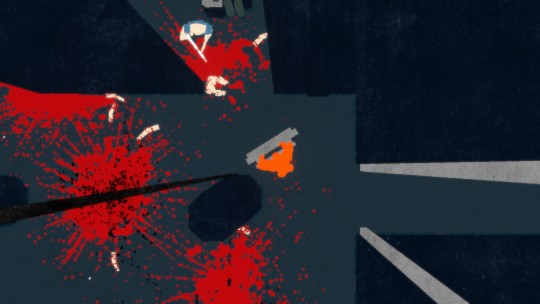
If this were a “coolest games” list, Ape Out would win it, easily. It’s a simple game whose mechanics don’t particularly evolve throughout the course of its handful of hours, but it leaves a hell of an impression with its minimalist cut-out graphics, stylish title cards, and percussive soundtrack. Smashing guards into each other and walls and causing them to shoot each other in a mad-dash for the exit is a fun as hell take on Hotline Miami-esque top down hyper violence, even if it’s a thin enough concept that it starts to feel a bit old before the end of the game.
8. Fire Emblem: Three Houses
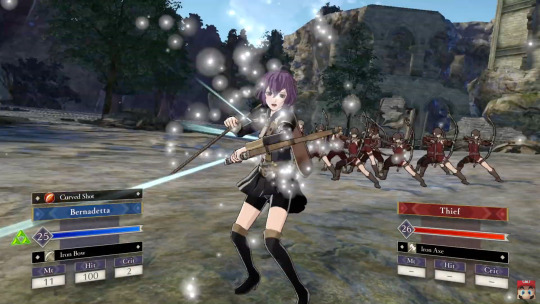
I had a lot of problems with this game, probably most stemming from just how damn long it is - I still haven’t finished my first, and likely only, playthrough. This length seems to have motivated the developers to make battles more simple and easy, and to be fair, I would get frustrated if I were getting stuck on individual battles if I couldn’t stop thinking about how much longer I have to go, but as it is, I’ve just found them to be mostly boring. This is particularly problematic for a game that seems to require you to play through it at least...three times to really get the full picture? I couldn’t help but admire everything this game got right, though, and that mostly comes down to building a massive cast of extremely well realized and likable characters whose complex relationships with each other and with the structures they pledge loyalty to fuels harrowing drama once the plot really sets into motion. There’s a reason no other game inspired such a deluge of memes and fan fiction and art into my Twitter feed this year. It’s an impressive feat to convince every player they’ve unquestionably picked the right house and defend their problem children till the bitter end. After the success of this game, I’d love to see what this team can do next with a narrower focus and a bigger budget.
7. Resident Evil 2
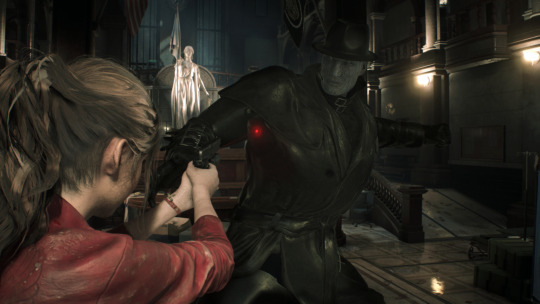
It’s been a long time since I played the original Resident Evil 2, but I still consider it to be one of my favorite games of all time. I was highly skeptical of this remake at first, holding my stubborn ground that changing the fixed camera to a RE4-style behind the back perspective would turn this game more into an action game and less of a survival horror game where feeling a lack of control is part of the experience. I was pleasantly surprised to find how much they were able to modernize this game while maintaining its original feel and atmosphere. The fumbly, drifting aim-down sights effectively sell the feeling of being a rookie scared out of your wits. Being chased by Mr. X is wildly anxiety-inducing. But even more surprisingly, perhaps the greatest upgrade this game received was its map, which does you the generous service of actually marking down automatically where puzzles and items are, which rooms you’ve yet to enter, which ones you’ve searched entirely, and which ones still have more to discover. Arguably, this disrupts the feeling of being lost in a labyrinthine space that the original inspired, but in practice, it’s a remarkably satisfying and addicting video game system to engage with.
6. Judgment
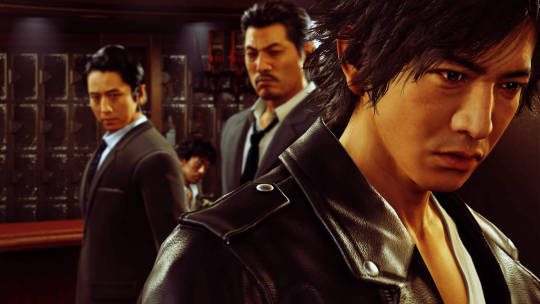
No big surprise here - Ryu ga Gotoku put out another Yakuza-style game set in Kamurocho, and once again, it’s sitting somewhere on my top 10. This time, they finally put Kazuma Kiryu’s story to bed and focused on a new protagonist, down on his luck lawyer-turned-detective Takayuki Yagami. The new direction doesn’t always pay off - the added mechanics of following and chasing suspects gets a bit tedious. The game makes up for it, though, by absolutely nailing a fun, engrossing J-Drama of a plot entirely divorced from the Yakuza lore. The narrative takes several head-spinning turns through its several dozen hours, and they all feel earned, with a fresh sense of focus. The side stories in this one do even more to make you feel connected to the community of Kamurocho by befriending people from across the neighborhood. I’d love to see this team take even bigger swings in the future - and from what I’ve seen from Yakuza 7, that seems exactly like what they’re doing - but even if this game shares maybe a bit too much DNA with its predecessors, it’s hard to complain when the writing and acting are this enjoyable.
5. Control
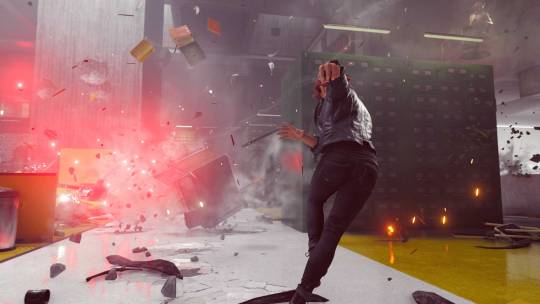
Control feels like the kind of game that almost never gets made anymore. It’s a AAA game that isn’t connected to any larger franchises and doesn’t demand your attention for longer than a dozen hours. It doesn’t shoehorn needless RPG or MMO mechanics into its third-person action game formula to hold your attention. It introduces a wildly clever idea, tells a concise story with it, and then its over. And there’s something so refreshing about all of that. The setting of The Oldest House has a lot to do with it. I think it stands toe-to-toe with Rapture or Black Mesa as an instantly iconic game world. Its aesthetic blend of paranormal horror and banal government bureaucracy gripped my inner X-Files fan instantly, and kept him satisfied not only with its central characters and mystery but with a generous bounty of redacted documents full of worldbuilding both spine-tingling and hilarious. More will undoubtedly come from this game, in the form of DLC and possibly even more, with the way it ties itself into other Remedy universes, and as much as I expect I will love it, the refreshing experience this base game offered me likely can’t be beat.
4. Anodyne 2
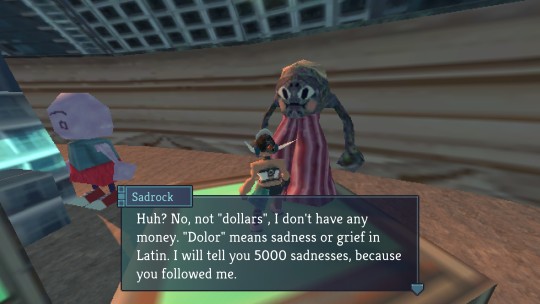
I awaited Sean Han Tani and Marina Kittaka’s new game more anxiously than almost any game that came out this year, despite never having played the first one, exclusively on my love for last year’s singular All Our Asias and the promise that this game would greatly expand on that one’s Saturn/PS1-esque early 3D graphics and personal, heartfelt storytelling. Not only was I not disappointed, I was regularly pleasantly surprised by the depth of narrative and themes the game navigates. This game takes the ‘legendary hero’ tropes of a Zelda game and flips them to tell a story about the importance of community and taking care of loved ones over duty to governments or organizations. The dungeons that similarly reflect a Link to the Past-era Zelda game reduce the maps to bite-sized, funny, clever designs that ask you to internalize unique mechanics that result in affecting conclusions. Plus, it’s gorgeously idiosyncratic in its blend of 3D and 2D environments and its pretty but off-kilter score. It’s hard to believe something this full and well realized came from two people.
3. Eliza

Eliza is a work of dystopian fiction so closely resembling the state of the world in 2019 it’s hard to even want to call it sci-fi. As a proxy for the Eliza app, you speak the words of an AI therapist that offers meager, generic suggestions as a catch-all for desperate people facing any number of the nightmares of our time. The first session you get is a man reckoning with the state the world is in - we’ve only got a few more years left to save ourselves from impending climate crisis, destructive development is rendering cities unlivable for anyone but the super-rich, and the people who hold all the power are just making it all worse. The only thing you offer to him is to use a meditation app and take some medication. It doesn’t take long for you to realize that this whole structure is much less about helping struggling people and more about mining personal data.
There’s much more to this story than the grim state of mental health under late capitalism, though. It’s revealed that Evelyn, the character you play as, has a much closer history with Eliza than initially evident. Throughout the game, she’ll reacquaint herself with old coworkers, including her two former bosses who have recently split and run different companies over their differing frightening visions for the future. The game offers a biting critique of the kind of tech company optimism that brings rich, eccentric men to believe they can solve the world’s problems within the hyper-capitalist structure they’ve thrived under, and how quickly this mindset gives way to techno-fascism. There’s also Evelyn’s former team member, Nora, who has quit the tech world in favor of being a DJ “activist,” and her current lead Rae, a compassionate person who genuinely believes in the power of Eliza to better people’s lives. The writing does an excellent job of justifying everyone’s points of view and highlighting the limits of their ideology without simplifying their sense of morality.
Why this game works so well isn’t just its willingness to stare in the face of uncomfortably relevant subject matter, but its ultimately empathetic message. It offers no simple solutions to the world’s problems, but also avoids falling into utter despair. Instead, it places measured but inspiring faith in the power of making small, meaningful impacts on the people around you, and simply trying to put some good into your world. It’s a game both terrifying and comforting in its frank conclusions.
2. Death Stranding
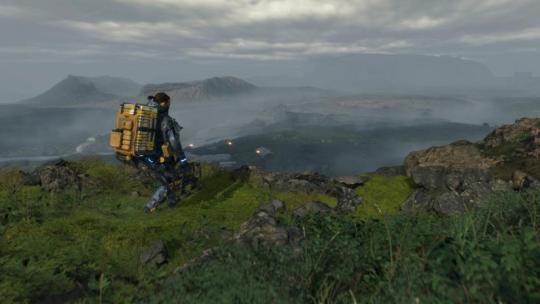
For a game as willfully dumb as this one often is - that, for example, insists on giving all of its characters with self-explanatory names long monologues about how they got that name - Death Stranding was one of the most thought provoking games I’ve played in a while. Outside of its indulgent, awkwardly paced narrative, the game offers plenty of reflection on the impact the internet has had on our lives. As Sam Porter Bridges, you’re hiking across a post-apocalyptic America, reconnecting isolated cities by delivering supplies, building infrastructure, and, probably most importantly, connecting them to the Chiral Network, an internet of sorts constructed of supernatural material of nebulous origin. Through this structure, the game offers surprisingly insightful commentary about the necessity for communication, cooperation, and genuine love and care within a community.
The lonely world you’re tasked to explore, and the way you’re given blips of encouragement within the solitude through the structures and “likes” you give and receive through the game’s asynchronous multiplayer system, offers some striking parallels for those of us particularly “online” people who feel simultaneous desperation for human contact and aversion to social pressures. I’ve heard the themes of this game described as “incoherent” due to the way it seems to view the internet both as a powerful tool to connect people and a means by which people become isolated and alienated, but are both of these statements not completely true to reality? The game simplifies some of its conclusions - Kojima seems particularly ignorant of America’s deep structural inequities and abuses that lead to a culture of isolation and alienation. And yet, the questions it asks are provocative enough that they compelled me to keep thinking about them far longer than the answers it offers.
Beyond the surprisingly rich thematic content, this game is mostly just a joy to play. Death Stranding builds kinetic drama out of the typically rote parts of games. Moving from point A to point B has become an increasingly tedious chore in the majority of AAA open world games, but this is a game built almost entirely out of moving from point A to point B, and it makes it thrilling. The simple act of walking down a hill while trying to balance a heavy load on your back and avoiding rocks and other obstacles fulfills the promise of the term ‘walking simulator’ in a far more interesting way than most games given that descriptor. The game consistently doles out new ways to navigate terrain, which peaked for me about two thirds of the way through the game when, after spending hours setting up a network of zip lines, a delivery offered me the opportunity to utilize the entire thing in a wildly satisfying journey from one end of the map to another. It was the gaming moment of the year.
1. Outer Wilds
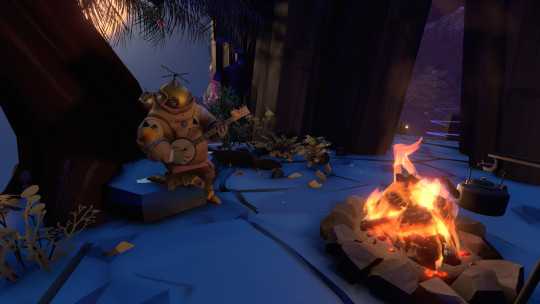
The first time the sun exploded in my Outer Wilds playthrough, I was probably about to die anyway. I had fallen through a black hole, and had yet to figure out how to recover from that, so I was drifting listlessly through space with diminishing oxygen as the synths started to pick up and I watched the sun fall in on itself and then expand throughout the solar system as my vision went went. The moment gave me chills, not because I wasn’t already doomed anyway, but because I couldn’t help but think about my neighbors that I had left behind to explore space. I hadn’t known that mere minutes after I left the atmosphere the solar system would be obliterated, but I was at least able to watch as it happened. They probably had no idea what happened. Suddenly their lives and their planet and everything they had known were just...gone. And then I woke up, with the campfire burning in front of me, and everyone looking just as I had left it. And I became obsessed with figuring out how to stop that from happening again.
What surprised me is that every time the sun exploded, it never failed to produce those chills I felt the first time. This game is masterful in its art, sound, and music design that manages to produce feelings so intense from an aesthetic so quaint. Tracking down fellow explorers by following the sound of their harmonica or acoustic guitar. Exploring space in a rickety vessel held together by wood and tape. Translating logs of conversations of an ancient alien race and finding the subject matter of discussion to be about small interpersonal drama as often as it is revelatory secrets of the universe. All of the potentially twee aspects of the game are balanced out by an innate sense of danger and terror that comes from exploring space and strange worlds alone. At times, the game dips into pure horror, making other aspects of the presentation all the more charming by comparison. And then there’s the clockwork machinations of the 22-minute loop you explore within, rewarding exploration and experimentation with reveals that make you feel like a genius for figuring out the puzzle at the same time that you’re stunned by the divulgence of a new piece of information.
The last few hours of the game contained a couple puzzles so obfuscated that I had to consult a guide, which admittedly lessened the impact of those reveals, but it all led to one of the most equally devastating and satisfying endings I’ve experienced in a video game recently. I really can’t say enough good things about this game. It’s not only my favorite game this year, but easily one of my favorite games of the decade, and really, of all-time, when it comes down to it.
#outer wilds#death stranding#eliza#anodyne 2#control#judgment#resident evil 2#fire emblem: three houses#Ape Out#Amid Evil#games#video games#GOTY
87 notes
·
View notes
Text
Video Game Year in Review: The Top 10
As with any year-end list, this one probably isn’t complete. Last year, I fell in love with Nioh over winter break after I had already made my top 10, and just a few days ago, I started playing Hollow Knight. As I made clear in my previous lists, Metroidvanias can be hit or miss for me. I can get fed up with wandering around without a clear destination, and Hollow Knight has a bit of that so far, but it also has one of the most atmospherically welcoming settings for a video game in recent memory, and so far I’ve been pretty damn enraptured by it. I’m not too worried about it making the list at this point; it didn’t even technically come out this year anyway, but its Switch release earlier this year gave it somewhat of a second debut, for all the earned attention it finally got. At least I got a little shout-out here before publishing.
Anyway, here’s ten games I loved the shit out of in 2018. This was one year with a handful of games that I absolutely adored, none of which necessarily immediately jumped out to me as hands down the best one of the bunch, and honestly, that’s the way I’d prefer it, but it did make ranking them a bit tough. Really, from number five onward, the ranking gets pretty interchangeable. I didn’t plan on the game in my number one spot being the one that it is until I actually wrote out my feelings for it and decided that out of all them it was the easiest for me to just gush about. Alright, no further ado:
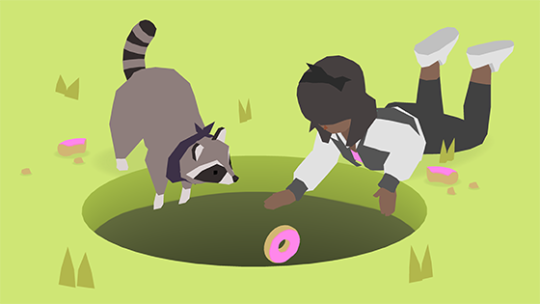
10. Donut County - Overall, it’s probably a good thing that Donut County isn’t longer than it is, but for as mechanically simple as sucking objects into an ever-expanding void is, it’s something that I felt I would’ve been perfectly entertained doing for a lot longer than the game lasted. Donut County has a wildly inspired and novel central gameplay hook, a relatably goofy sense of humor that might border on obnoxious if it weren’t so sincerely delivered, and an anti-gentrification, anti-capitalist message that mostly works without beating you over the head too hard with it. Ben Esposito and his team have created one of the most charming and original games I’ve played in years here.

9. Paratopic - “Cinematic” is a grossly overused and frequently inappropriate word to use in games criticism, but this game often had me coming back to the word, observing how many ways it feels like it authentically takes inspiration from creative methods seen more often in film, particularly art films, than in games, much more so than say, Red Dead Redemption 2, which typically embarrassingly pales in comparison to any movies it’s obviously aping from. There’s its willingness to not explain to you what’s going on, letting you pick up on clues from scenery and incidental dialogue. Its multiple switching perspectives, laced together to draw meaningful narrative connections. Its tendency to sit in the atmosphere of a scene. Its ability to tell a succinct story intended to be experienced in one sitting. And most of all, those jump cuts. I know Paratopic isn’t the first game to employ this technique, but as far as I can remember, it’s the first that I’ve played to utilize them for purposeful artistic effect, and every time it happened, it was oddly thrilling. I loved when I’d switch from walking to suddenly driving, and had a moment of panic, as if I suddenly just woke up at the wheel. The cliffhangers scenes would occasionally end on made me desperate to get back to that thread. Hell, even just the fact that there clearly were scenes, that lasted a few minutes at a time, then moved on to the next one, felt weirdly refreshing at a time when AAA design is becoming so absurdly bloated. Paratopic excited me, not in its desire to emulate a separate art medium, but in its casual realization of how many underutilized narrative techniques work genuinely effectively in this medium.
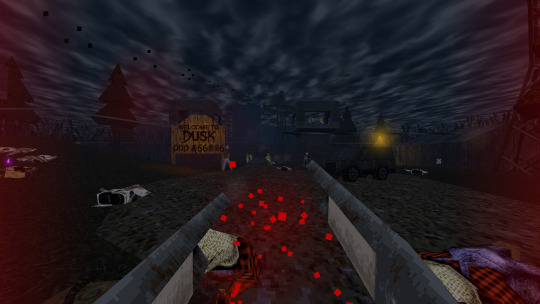
8. Dusk - I really can’t imagine a game that more perfectly matches my Platonic ideal of “video game comfort food” than Dusk, aside from, maybe, the game in the number one spot of this list. I was raised on 90’s PC FPS games like Doom and, as is much more relevant to this game, Quake. Yeah, for the most part, it’s nice that games have moved on, both in depth of gameplay and artistry, but goddamn does a back-to-basics twitchy shooter with inspired level design and creepy atmosphere just feel good sometimes. The grainy, chunky polygons of this game encapsulate everything I love about the rudimentary but remarkably evocative minimalism of early 3D graphics. The movement feels absurdly fast by modern standards, and the effect is thrilling - every projectile is dodgeable, as long as your reflexes are sharp enough. Undoubtedly the most impressive thing about this game is its ambitious level design, so much of which rivals even John Romero’s. The longer this game goes on, the more sprawling and labyrinthine it becomes. The map shapes become increasingly wacky. The gothic architecture becomes more foreboding and awe-inspiring. Dusk does a lot with a little, and in the process, makes so much more than a tribute to game design and aesthetics of the past - for me, it stands right alongside its obvious inspirations as one of the very best of its ilk.
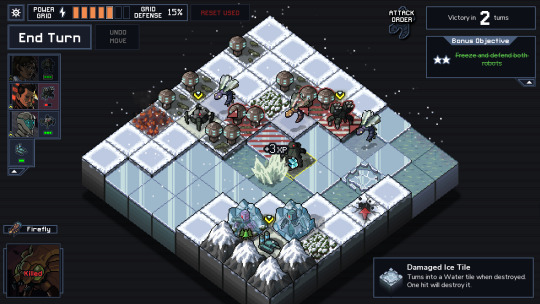
7. Into the Breach - An absolute masterclass of game design. Into the Breach leaves nothing about its mechanics obscured, making sure you understand how every move is going to go down just as well as it does, and the fact that the result is still compellingly challenging is a sure sign we’re in the hands of remarkably skilled and intelligent developers. The narrative in this game is sparse - you assume the role of time-looping soldiers attempting over and over again to save your world from alien invasion (think Edge of Tomorrow), and that’s pretty much all you get for the plot, aside from some effective but minimal character beats and dialogue one-liners. And yet, every battlefield, a small grid with its own arrangement of sprites (giant creepy-crawlies, various creative mech classes, structures full of terrified denizens given a modicum of hope at the arrival of their ragged potential saviors) offers a playground for drama to unfold, as gripping and epic as any great mecha anime battle. As I mentioned in my previous list with Dead Cells, I have trouble sticking with run-based games, and this game wasn’t quite an exception - honestly, if it had something resembling a more traditional narrative campaign, I could see it potentially filling my number one spot. But that a game of its style nevertheless stuck with me as well as it did proves what a tremendous achievement I found it to be.
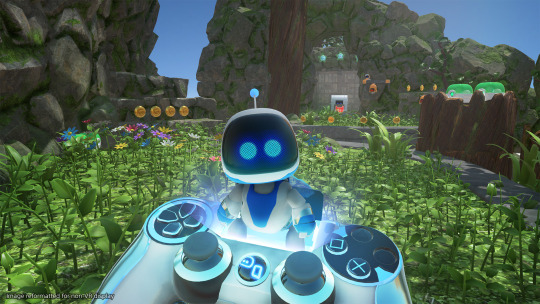
6. Astro Bot Rescue Mission - This was both the first game I’ve played fully in VR and the first game I’ve ever platinumed. I guess that might say something about how thoroughly I fell for it. For some reason, one of the questions that my brain kept posing while playing this game is, “would you like this game as much if it weren’t in VR?” I would like to pose that first off, if this wasn’t a VR game, it would be quite a different game, but yes, probably a perfectly delightful 3D platformer in its own right. But most of all, this game helped me realize what a bullshit question that is in the first place. By virtue of its VR nature, this game is just fundamentally different, just as the jump from 2D to 3D resulted in games that were just fundamentally different. The perspective you’re given watching over your little robot playable character allows to look in 360 degrees, and often you need to, if you’re seeking out every level’s secrets, and yet, while it moves forward, it doesn’t follow you vertically, so sometimes you’re looking up or down as well. It’s difficult to describe exactly how this perspective is so much more than a gimmick or something, outside of the cliched exaggeration of “it feels like you’re really there, man,” but honestly, this statement isn’t wrong. I truly did feel immersed in these levels in a way that I wouldn’t have if this weren’t a VR game, and while it’s not exactly a feeling I now desire from every game, it does stand out as one of the singular gaming experiences I had in 2018 as a result.
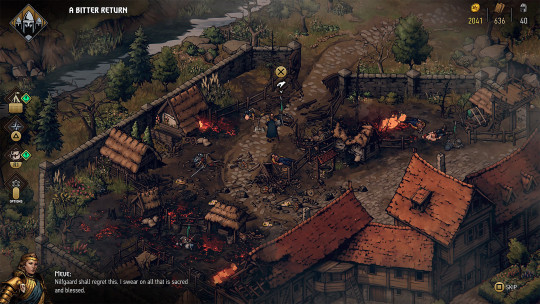
5. Thonebreaker: The Witcher Tales - I gushed plenty about this game in my review. How its approach to Gwent-based combat is both welcoming to newcomers and remarkably varied, offering new ways to approach and think about the game with nearly every encounter. How its sizable story is filled with fascinating characters and genuinely distressing choices, forcing you to grapple with the inherent injustices of your position. How its vivid art style and wonderfully moody Marcin Przybyłowicz score sell The Witcher feel of this game, despite how differently it plays from the mainline entries of the game. And maybe most of all, how criminally overlooked this game has been. So I’ll make the same claim I did before - if The Witcher 3: Wild Hunt did something for you, it’s likely this game will too. Don’t worry about the card game - I did too, and trust me, it’s fun. It’s the new Witcher game; that really ought to be all you need to know.
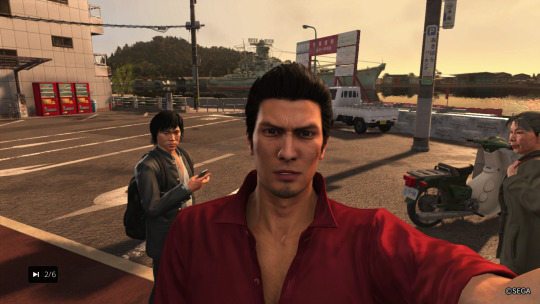
4. Yakuza 6: The Song of Life - There’s...a lot about the Yakuza games that I’ve come to adore, but one of the biggest ones that kept sticking out to me while playing The Song of Life is how they build a sense of place. After playing Yakuza 0, set in 1988, and Yakuza Kiwami, set in 2005, I played this one, set in 2016. Each time, same Kiryu, but older, same Kamurocho, but era appropriate. Setting every Yakuza game in the same map has to be one of the quietly boldest experiments in video games, forgoing fresh new vistas to explore in favor of the same familiar boulevards, alleys, and parks of the iconic red-light district, painting an exquisitely detailed and loving portrait of a neighborhood changing with the decades. While Kiryu’s exasperation at once again walking into the all-too-familiar crowded streets of Kamurocho, brighter and louder than ever, hardly matched my eagerness to see how it had changed, it felt appropriate. Though he’s still the hottest dad (grandpa?) in town, he is kinda old now, and he’s certainly earned the right to just be over it a little. Even the silliest of the era-relevant sub stories (one of which delightfully features Kiryu putting a selfie-stick wielding, obnoxious-stunt pulling, wanna-be influencer shithead in his place) serve to underscore how out of place he now is in his old stomping grounds.
By contrast, the other setting of Yakuza 6, the quaint seaside town of Onomichi, very quickly begins to feel like an idyllic retirement destination. The introduction to this part of the game has to be my favorite video game moment of 2018 - Kiryu trying to calm a hungry baby, while walking the deserted streets after dark in search of one store that still happens to be open. The faint sound of ocean in the distance effectively evokes the freshness, the bitterness, of the air. The emptiness and darkness of the space is almost shocking, compared to the sensory overload of Kamurocho. And there’s Haruto. Kiryu took Haruka in when she was 9, so he’s never had to deal with a baby before. He’s out of his element, but hardly unwilling. The help he gets from Kiyomi and his other new friends is the kind of comfort Kiryu needs at this point in his life. Likewise, the events in Onomichi play out like a retirement fantasy - building an amateur baseball team out of local talent, building relationships with the denizens of a bar in an incredible Japanese version of Cheers, hanging out with the town’s Yakuza, who are so small potatoes they seem to barely fit the definitions of organized or crime. It all works beautifully as a touching send-off to my favorite video game character.

3. Tetris Effect - There was a long time where I was contemplating putting this as my number one game. I went through some strange conflicts in the consideration - next to all these original, thoughtful games, am I really going to say that fucking Tetris is best one of them? Is that even fair? Is this game really anything more than just regular-ass Tetris but with some pretty lights and sounds and a 90’s rave kinda vibe? The answer to all of these, is, of course, yes, but also no. I’d defend my choice any day, though. This is the first game to actually get me into Tetris. I always appreciated it; it’s a classic, but it was never a game I had actually put much time or thought into before. This game not only sold me on Tetris, but got me obsessed with it, to the point where the name feels remarkably appropriate: ever since I began playing, I’ve been seeing tetriminos falling - in my sleep, in daydreams, any time I see any type of blocky shape in real life I’m fitting them together in my mind. The idea that all Tetris pieces, despite their differences, need each other and complement each other and can all fit together in perfect harmony, and that this is a metaphor for humanity, has to be some of the cheesiest bullshit I’ve ever heard, and yet, the game fully sold me on it from the first damn level. It’s all connected. We’re all together in this life. Don’t you forget it.
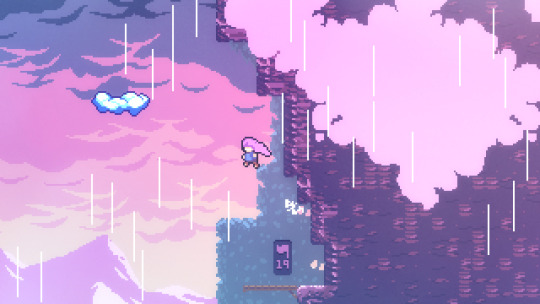
2. Celeste - This is a damn near perfect game, both as refreshing and demanding as a climb up a beautiful but treacherous mountain ought to be. I died many, many times (2424, to be exact), but the game explicitly encouraged me to be proud of that, acting as a friendly little cheerleader in between deaths, assuring me that I could do it. It’s both a welcome break from the smug, sneering attitude so many “difficult” games tend to traffic in, and absolutely central to its themes involving mental health. As the shockingly good plot starts making it increasingly clear that it’s about Madeline’s quest to conquer (or, at least, understand) her inner demons, the gameplay itself offers a simple but effective metaphor for struggling with mental illness - yes, it’s hard, and yes, you’re going to suffer and struggle, but you can make it, and you will make it, because you’re so much better than you think you are. Oh, and also, it’s not all bad, because at least you get to listen to some absolutely rippin’ tunes while you do it.
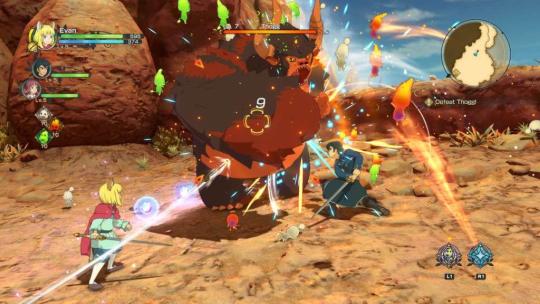
1. Ni No Kuni II: Revenant Kingdom - (Another one I reviewed!) This is my ideal JRPG. In my mind it stands next to childhood treasures like Final Fantasy IX. Unlike some recent Square projects that specifically try to clone their late 90’s output, this game hardly feels beholden to the game design of the past, and yet, feels of a piece with that era in a respectably non-cloying way. It has a bright, colorful, inviting world full of charming characters, an all-time great soundtrack by Joe Hisaishi, and an exciting, deep combat system with an emphasis on action. Building my kingdom of Evermore was remarkably satisfying, down to all the little dumb tasks my citizens would ask of me, none of which my very good boy King Evan was too busy or too proud to refuse. There’s very little grinding. It’s a long game by most standards, but at 40-something hours, it feels lean by JRPG standards. And for as much of a storybook fantasy as the plot is, as much as it reduces woefully complicated socio-political issues into neat, resolvable tasks for Evan to solve, it always came across as perfectly genuine, and sometimes surprisingly affecting. It’s the game that I’ve wanted to play since the PS1 Final Fantasy games stole my heart as a kid. That’s hardly what I expected it to be as I started into it, and what a joy it was to discover that it was.
#Ni No Kuni#Ni No Kuni II#Ni No Kuni II: Revenant Kingdom#Celeste#Tetris#Tetris Effect#Yakuza 6: The Song of Life#Yakuza#Yakuza 6#Thronebreaker#Thronebreaker: The Witcher Tales#The Witcher#Astro Bot#Astro Bot Rescue Mission#Into the Breach#Dusk#Paratopic#Donut County#Review#List#Game of the Year#GOTY#Top 10#game#Games#video game#video games#criticism
5 notes
·
View notes
Text
Video Game Year in Review: Honorable Mentions
When I compiled the list of games I played this year that didn’t make it to my top 10, and weren’t remasters, remakes, or re-releases (see previous list), the number came out to just over 10, with the few over the 10 spot either just not being particularly remarkable (Splatoon 2: Octo Expansion) or games that I put so little actual time into that I really didn’t get the chance to form coherent thoughts about them (Prey: Mooncrash and BattleTech, both examples of types of games I want to resolve to not be so afraid of playing in 2019).
So the remaining 10 that I did want to mention are an interesting bunch. Not all of them are games that I loved. A decent amount of them are games I had serious issues with. But they all had something to them, something that made those issues that I had all the more frustrating, because it prevented me from dismissing them outright. My feelings about these games are varied enough that I wanted to rank them, so I suppose this list could just be called “Reese’s Top 20 games of 2018: 20-11,” or, “The Problem Children,” or something, but “Honorable Mentions” works fine for me.
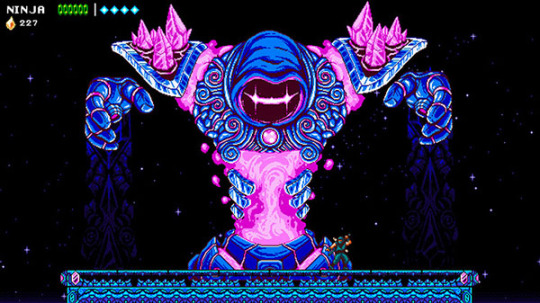
10. The Messenger - Though I have never played Ninja Gaiden, and therefore don’t really have any nostalgia for the type of game this dual-8-bit/16-bit/action-platformer/Metroidvania was clearly going for, the early parts were executed pretty damn well. Tight controls, great music, some very fun and memorable boss fights, gameplay that was challenging but not, I imagine, anywhere near as rage-inducingly challenging as the games it was based on. Those initial four or five hours or so felt enjoyable and complete enough that the fact that I fell off pretty soon after the game pulls a very significant aesthetic and gameplay shakeup not enough to make me hate the game. As cool as a concept as it is to literally jump back and forth between different eras of game design, the “Metroidvania” part of this game was filled with the shit that tends to frustrate me about that style of game - aimless wandering and tedious backtracking. A very interesting experiment that, for me, didn’t quite pay off, but the effort produced a pretty unique game.

9. Iconoclasts - As far as its gameplay goes, this game is almost the inverse of The Messenger’s brand of Metroidvania, highlighting all the things that I actually can love about the genre. Sure there’s backtracking, but the layout of the levels is thoughtful and inspired enough that it rarely feels tedious: I often found myself very excited to gain my new ability and revisit a previous area because - just like the best Metroid games - I know exactly where I can use it, have been wondering about it for a while, and can finally see what’s on the other side. What ended up bogging down the experience of this game for me was the surprising emphasis on story and long-winded dialogue scenes. While I definitely really liked a handful of characters, the game’s increasing willingness throughout its run-time to put verbose speeches in all of their mouths wore a bit thin, given how thoroughly okay the general plot was. Still, game has some of the absolute most gorgeous pixel animation I’ve ever seen.

8. Monster Hunter World - As it seemed to be for many, the streamlined (though still irritatingly idiosyncratic) systems management, lush world and creature design, and conveniently slow part of the year that it released all made this the first Monster Hunter game I was willing to fully commit to. For a while, the game really won me over - experimenting with weapons was deeply satisfying, and the care and evocative detail in the designs felt inspired and compelling. I even played a bit of multiplayer with friends, and had a lot of fun with it, despite how generally committed I tend to be to single player experiences. After a while, though, I stopped being wowed by the animations and controls to start to be bothered by how careless the game seemed to be about its colonial fantasy, what a generally destructive force you and your team are on this beautiful world. It’s not as though this isn’t something that was obvious from the beginning, it’s just that for a while there, I figured it must actually be going somewhere with it, that there must be some commentary it was building toward. What I was met with was disappointing silence, and LOTS of grinding.
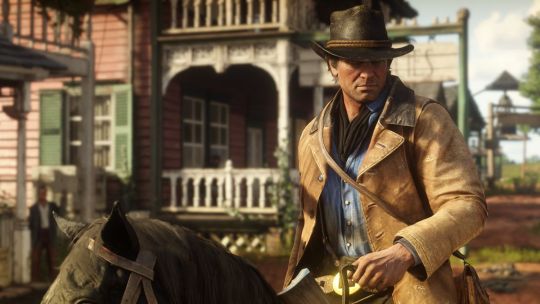
7. Red Dead Redemption 2 - I felt a lot of ways about this game, some of which I managed to capture in the review I wrote a couple months ago. There’s so much about this game that I hold against it and Rockstar, both surrounding it (the abusive culture of crunch in its development, their lack of care in getting an indigenous and/or black actor to play Charles) and within the game itself (the stretching of a decent story to an absurd length, controls so clunky they often broke the role-playing the rest of the game was so good at encouraging). But the things that I loved about this game - the stunningly atmospheric world, the complicated and nuanced character dynamics in the camp, the ways in which it allows one to experience and engage with its details - all stuck with me as well. This game represents so much of both what I want games to be going forward and what I never want them to be again.
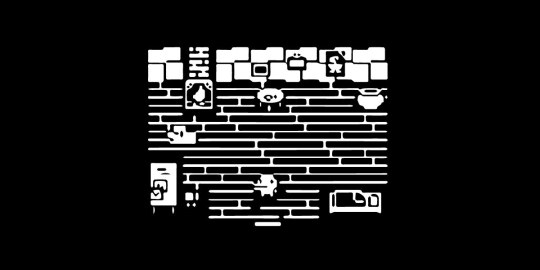
6. Minit - Weird as it sounds, as much as I liked this game, my main gripe with it was the primary mechanic around which it was based. I loved the minimalist black-and-white art style: the way the white lines shined on my HDR TV is an excellent example of how “simple” graphical styles can take advantage of modern technology as well as any graphically demanding powerhouse. The world was a joy to explore, a miniature Zelda with a unique sense of humor. I honestly just never got why I was only allowed to enjoy it a minute at a time. The game seemed to do little to justify its central hook, and most of the time it ended up feeling more like a hindrance than a meaningful game changer. Nevertheless, Minit gave me a short, sweet experience that stuck with me more than I expected it to.

5. God of War - Having never really liked the previous games in this series, I went into this one with fairly low expectations, despite the near-universal praise it was getting. The story really didn’t do much for me. The father/son dynamic was fine, but hardly the innovative step forward in video game narratives many seemed to claim it was. Kratos is still an inherently ridiculous character, no matter how much depth they try to give him in this game, though I did thoroughly enjoy Christopher Judge’s performance. The real hook of this game, outside of its very pretty visuals, is its really just superb combat. They nearly entirely did away with the hacking and slashing of the previous games, and created a deliberate, thrilling system of combat juggling. There are a decent amount of moves at your disposal, but it never feels like an overwhelming amount, and the balancing act you can achieve in utilizing all of them properly results in just some of the most satisfying combat I’ve ever experienced in a game.
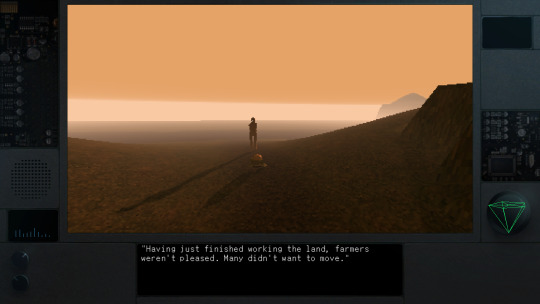
4. All Our Asias - This was the first of several lo-fi 3D polygonal games I played this year - the others will show up in my top 10 - and I’m just so excited about the coming wave of game developers inspired by 90’s PS1-era aesthetics, an era I’m personally much more nostalgic for than the still-prevailing 16-bit pixel art of many indie games. This is probably also the weirdest of that style of game that I played this year (and given what one of the others is, that’s saying something), an essay in video game format, an exploration of the bizarre nature of memory, told through abstract shapes and landscapes. Creator Sean Han Tani tells a wonderfully personal story here about racial identity and complicated family relationships, by navigating the conceptual framework of your player character’s father. It’s a singular experience that I still think about often, nearly a year after playing it.

3. Mario + Rabbids: Kingdom Battle - Donkey Kong Adventure - I’ll admit that my time with Mario + Rabbids: Kingdom Battle last year was my first real dip into tactics gaming, an experience that allowed me to gingerly step my foot into some deeper water this year (some of which I discovered was still too deep for me, like BattleTech). But for as easy as the first half of that game was, I maintain that the back half was surprisingly challenging. This year’s DLC, Donkey Kong Adventure, is not challenging. Donkey Kong is so overpowered it feels like it must have been a mistake, and the way that he can combine attacks with other characters is just ridiculous. But, weirdly enough, that’s part of what I enjoyed about this addition, a fairly breezy few-hour adventure where the most fun comes from seeing just how badly you can fuck some Rabbids up in a single move. Having Donkey Kong grab an enemy, throw him at another enemy, hit both plus a nearby enemy his banana boomerang, then having Rabbid Cranky charge into all three of them and blast them with his shotgun-esque Boombow never really gets old, at least for the well paced 8 or 9 hours that the game lasts.

2. Dead Cells - An endless, side-scrolling action platformer with tight-as-hell, ultra satisfying combat, beautiful art design, AND it was made by team of French socialists with no bosses who all get paid the same? I mean, fuck yeah. Dead Cells, a game that I originally played a bit in Early Access last year, and enjoyed so much that I decided to wait until the official release before truly delving into it, is a game that largely plays like the dream it sounds like on paper. I’m not sure if I’ve ever played at 2D game with combat as good. Generally, I’m not huge on run-based games, and did hit some walls in this game where I just felt like my own ineptitude was getting in the way of my enjoyment, and the game wasn’t giving me much between runs to make me feel like I was actually making any progress. I still haven’t actually beat it, but it’s become my default palate cleanser game that I play a few rounds of in between other games or while listening to podcasts or music, so I’m still plucking away at it. I’ll get there someday.

1. Return of the Obra Dinn - I enjoyed this game so, so much, even if sometimes more on a theoretical level than a practical one. The style is impeccable - I really will never get tired of the brief tease of opaque, incidental dialogue or sound, followed by the sudden explorable tableau of death(s), soundtracked by haunting strings. The gameplay is inspired - I’ve had few gaming experiences in recent memory as fulfilling as any time the little music que popped up after I solved a death, confirming that I had gotten three deductions correct. I have to admit, though, that those moments were spread further out than I would have wished. Part of this is just happenstance - I didn’t realize until quite a few hours into this game that by zooming in on someone, you’ll match them to their picture, something that would have undoubtedly saved me a lot of frustrating time in which I was grappling with trying to figure out whose fuzzy faces were whose. Nevertheless, I felt like I was too often given too little information, and had to take guesses between one of a few possible suspects, many of which were informed by racial assumptions that made me actively uncomfortable. This was, no doubt, part of the point, so it’s hard for me to hold it against the game, but it regardless did lead to a pretty exasperated final couple hours of play. Despite these complaints, its hard for me to think of this game as anything other than a wildly successful achievement - innovative, inspired, both intelligently designed and remarkably trusting in its player’s intelligence. Maybe a little too trusting, in my case.
#Return of the Obra Dinn#Dead Cells#Mario + Rabbids Kingdom Battle Donkey Kong Adventure#All Our Asias#God of War#minit#Red Dead Redemption 2#Monster Hunter World#Iconoclasts#The Messenger#video games#games#review#gameoftheyear#podcast#criticism
0 notes
Text
Video Game Year in Review: Remakes, Remasters, and Re-releases
I’ve never made a list of remakes, remasters, and re-releases before, but then again, I don’t think I’ve ever played so many in a single year to even be able to. 2018 was a particularly busy year in this end of video game releases, nearly exclusively due to the Nintendo Switch. Now in its second year, the Switch may have been light on brand new first party titles, but the rush of seemingly every developer to get new and old games alike on the portable console came into full swing. “When’s that game coming to Switch?” has turned into a question that could be reasonably applied to...just about every game, but perhaps no more so than great Nintendo games originally released on their previous, unsuccessful console, the Wii U. These games enjoyed a second life in 2018, with many, including myself, playing 2014 games that we never got to as if they’re brand new. Switch re-releases don’t account for every game on this list, but they are a very clear majority...

5. Bayonetta (Switch remaster) - This is the one game on this list that I actually didn’t like. But I tried. Like it’s spiritual cousin, Devil May Cry, Bayonetta is a game that makes you feel shitty for not being good at it. I consistently got low grades on my combat performance, but didn’t feel like the game was offering any particularly helpful guidance in how to improve. It just kept pushing me forward, with dwindling currency, supplies, and patience, all the while just being a bit of a dick to me. If I found gameplay to be more fun, maybe I also would have been more willing to be entertained by its puerile, edgy aesthetic, but as it was, that just became another thing to grate on my nerves. If there’s one thing I gained from this game, it’s the assurance that not every popular game from the late 2000’s that I missed out on while I was barely playing video games is worth catching up on.

4. Donkey Kong Country: Tropical Freeze (Switch re-release) - The Donkey Kong Country games have always eluded me. I never had a SNES, so I couldn’t quite get into the bizarre proto-3D graphics of the originals once I finally checked them out. Tropical Freeze is the game that finally proved to me why people love these games so much. Donkey Kong is an unusual platforming star - his hulking frame gives him a slightly out of control momentum that is off putting until it’s suddenly satisfying, and that moment within the first couple hours of play where how to control him suddenly clicked was the start of two weeks of compulsively playing this game to completion during my summer break.
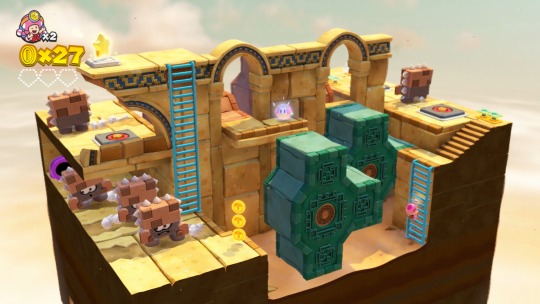
3. Captain Toad: Treasure Tracker (Switch re-release) - What a unique game. A puzzle platformer whose main mechanic sometimes feels like your player character’s lack of an ability to jump. With a perfectly minimalistic mobility design ethos, this delightful experiment encourages you to explore the little 3D dioramas that make up its levels to completion. I’ve been obsessively mining each of them for all they’ve got before moving on to the next one, and it’s slow going - I’ve still probably got about ⅔ left of the game to go. But the thought of it is actually making look forward to my upcoming, otherwise painfully long flight to Japan, because absorbing myself in this seems like the perfect way to make hours go by without notice.
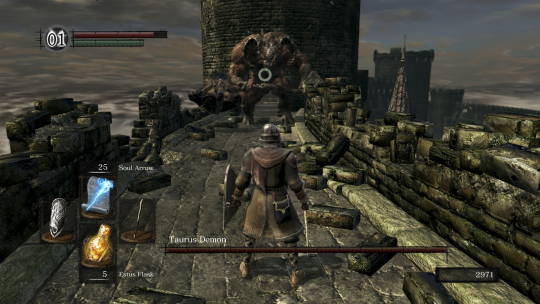
2. Dark Souls: Remastered - Before this remaster, I had played brief moments of the original Dark Souls on a friend’s PS3. Really, though, Bloodborne is where I fell in love with Souls-style games, and last year I obsessed over the excellent, overlooked Nioh. Finally coming to this game after more recent games in its style was a mixed experience for me. Obviously, the rather plain, blocky textures of the last generation are already aging quickly, but the game still has enough style and atmosphere that I wasn’t particularly bothered by that aspect of it. The combat, however, felt...bland. I know, I know, this game and its predecessor, Demon’s Souls, are praised for revolutionizing action RPG combat, with their tight controls and deliberate moves. If it weren’t for this game, the combat I love in Bloodborne and Nioh wouldn’t exist. But having put so many dozens of hours into Nioh, a game with combo attack strings and multiple stances, made the switch back to a game where each weapon basically only has two attacks, feel just kinda elementary. Not easy, mind you - despite my experience with this style, I still found this game to be welcomingly challenging, but performing the same moves over and over again just wore thin.
Nevertheless, this game has something that no game inspired by it has quite been able to replicate, or even, seemingly, really tried to, and that’s the incredible, interlocking level design. Yeah, Dark Souls 3 and especially Bloodborne obviously pull some similar magic tricks in connecting separate sections together, but regardless, feel like fairly linear games. Firelink Shrine in this game has three separate directions you can head in to start with, and the paths just keep branching from there. This game puts remarkable trust in the player in her ability and desire to explore, experiment, and undoubtedly die many times before finding the path of least resistance (because even that path offers plenty of resistance). This is the aspect of Dark Souls that kept me going. Not only has it not aged a day, it’s almost even more impressive in retrospect, a lightning-in-a-bottle kind of flash of creative genius.

1. Yakuza Kiwami 2 - Last year’s Yakuza 0 was my first Yakuza game, and this year’s Yakuza Kiwami 2 was my fourth. As you might have guessed, I’ve fallen very, very hard for this series. For those not familiar, Kiwami 2 is a remake of Yakuza 2, originally on PS2, just as last year’s Yakuza Kiwami was a remake of the original game. While that game used 0’s engine, which was made for PS3 originally, Kiwami 2 uses the brand new, very pretty engine used for Yakuza 6: The Song of Life, which was released earlier this year. This game recreates just about everything in the original game, and adds a hell of a lot more. This feels so much like a brand new game to me that I considered just putting in on my main top 10, and honestly, the reason that I didn’t had less to do with the fear of breaking any non-existent rules about what qualifies for a year-end list, and more to do with the fact that The Song of Life was already on there, and I just wanted more space to talk about how much I love the shit out of Yakuza.
This game improves on Kiwami in just about every aspect. The main story is a lot more compelling, and it’s obvious that Yakuza 2 is tonally where this series really came into its own, with its so-serious-it’s-actually-kinda-funny Japanese gangster soap opera, mixed with deliberately silly as hell sub stories. In particular, there are two very deep and expansive side stories built around mini-games added to this game: the cabaret club management game borrowed and modified from 0 and the Majima construction clan battles borrowed and modified from The Song of Life. While I appreciated these in those respective games, something about the execution in this game just got me absolutely obsessed. Kiryu’s roll that he fits into with the misfit hostesses of the cabaret club and their scrappy underdog story is my happy place. The older professional wrestlers that play the mumbly, grumpy businessmen/fighters in the clan battle mini-game led to a couple of scenes that had me gleefully cackling out loud. Starting this game out, I had arguably already spent more than enough time playing Yakuza games over the last couple years, but it’s a testament to just how endearing this game is that after 40 or so hours of play, if Kiwami 3 were to suddenly be surprise announced and released, I would have been happy to jump straight into it.
#Yakuza#Yakuza Kiwami 2#Yakuza Kiwami#Yakuza 0#Yakuza 6: The Song of Life#Dark Souls#Dark Souls: Remastered#Bloodborne#Nioh#Dark Souls III#Captain Toad#Toad#Captain Toad: Treasure Tracker#Switch#Nintendo#Nintendo Switch#PS4#Sony#From Software#Donkey Kong Country#Donkey Kong#Donkey Kong Country: Tropical Freeze#Bayonetta#Bayonetta 2#Devil May Cry#video games#criticism#podcast#review#list
0 notes
Text
Thronebreaker: The Witcher Tales is so much more than a Gwent-based spin-off

I put about 150 hours into The Witcher 3: Wild Hunt. It’s probably my favorite game ever. I tend to think that I’ve more or less done everything in that game that there was to do, but there is one glaring exception to that: Gwent. I tried a couple rounds of the collectible card game in the beginning of the game, didn’t quite understand what was going on, and certainly didn’t care to learn when the rest of the game offered a big, beautiful world to explore, full of great stories created with near unparalleled writing. I had never really gotten in to card games within video games in general, really - I remember reacting to Final Fantasy VIII’s Triple Triad in much the same way. And I’ve certainly never attempted Hearthstone, or any such similar DCCG’s. This is all to say, I’m still a bit surprised at how thoroughly I fell in love with Thronebreaker: The Witcher Tales, a game built largely around Gwent.
CD Projekt Red’s newest game was released just a few weeks ago to disappointingly little fanfare. What reviews there are have been pretty strong, but let’s be real - this is an isometric RPG with visual novel elements whose combat is based around a card game, and it was released three days before Red Dead Redemption 2. It’s a shame, though, because the game really does offer so much to those who, like me, might be unsure about undertaking such an experience. It’s got a gorgeous, comic-book-esque art style that makes exploring the game’s detailed maps a joy. It’s very well written, with novelistic prose and strong characters delivered by Jakub Szamalek, one of the writers from The Witcher 3. Marcin Przybylowicz returns with another memorable and moody Polish-folk-music-inflected score. While combat is entirely based around Gwent, the rest of this game is devoted to exploring detailed maps and making hard, morally ambiguous decisions in the main story. In other words, the team behind The Witcher 3 made a brand new, full, deep RPG set in the universe of The Witcher, and you really should be paying attention.
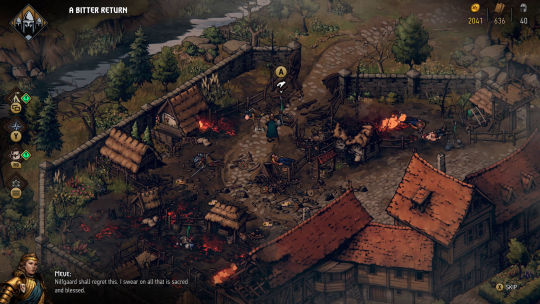
Thronebreaker is a prequel-ish spin-off, set just before the events of the first Witcher game. It centers around Meve, Queen of Lyria and Rivia, and her quest to reclaim her land from a devastating Nilfgaardian invasion. The morally gray nature of The Witcher universe is an even more ever-present central tenet in this game than previous ones, as it deals explicitly with the inherent injustice of monarchical governance. Meve is, as queens go, a very good one. She’s brave, determined, and compassionate, willing to fight to the death for the good of her people. But war nevertheless makes for hard decisions, especially when you’re leading a small army with limited resources against a giant imperial machine, and attempting to navigate the complex politics of multiple lands.
The maps you explore in this game can include big cities and castles, but for the most part, you’re traversing through rural lands, passing by small villages and farms, grappling with the cruelty of feudalism. The peasants you meet have next to nothing to begin with, so often are they forced by the government you rule to give up their earnings, at least in part so that you can live in luxury. Now that war has come around, it only gets worse for them - you physically take resources from them for your army, and often conscript them to join. You stick your nose into local conflicts you don’t fully understand or appreciate. Mass inequality and injustice are everywhere, and try as you might to be a just and fair monarch, you can only go so far when your existence is one of the primary reasons for that mass inequality and injustice.
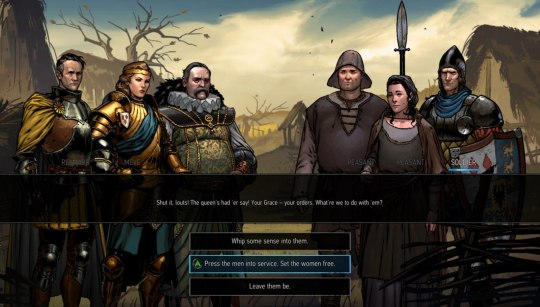
There are rarely “good” options to choose from in this game. A decision always involves a compromise, and no matter what, somebody is going to be made very unhappy by it - most likely including you. There are often more ostensibly righteous or noble options, but the consequences of those can sometimes have an effect that makes you wish you had chosen the other one. “You’ve chosen one evil over another” is a prompt that you get very used to popping up - it’s the game’s sole response to you making a story-altering decision. Sometimes this can feel pretty damn off. Sorry, game, but choosing not to kill a messenger when I’ve just been reminded of the rules of war, or saving an elf from a mob of racist humans attempting a public execution are just not evils, no matter how you look at them. The point of it is showing how your actions, even seemingly altruistic ones, have consequences, and the shades of gray thing works pretty well for the most part, but despite the game’s assurance to the contrary, not every choice you make is an evil one.
The more successful decision making comes when you really feel those consequences, either through a hit to your resources, or a bit of writing that explains what ended up happening. There’s a heavy dollop of Machiavellianism to these decisions, as it often comes down to choosing between what’s right and what’s successful. You need gold, people, and resources to survive. In the early parts of the game, you’re pretty desperate for all three of these things. So when you stumble across an already disturbed grave that has valuables in it, do you pillage it? You want to say no, and yet, you weigh the options - the only negative would be upsetting company morale, but morale is already high after saving a church graveyard from a monster, so pushing it down to normal isn’t a great loss in comparison to leaving behind gold. In that same section, you can chase down a group of bandits that stole gold from the church. After you retrieve it, you can either return it, or keep it for yourself. I returned it, but I didn’t feel quite as great about it as I expected to. Sure, I made a small group of nuns happy, but does this truly benefit the kingdom as a whole if we’re short on money to fight our enemies?
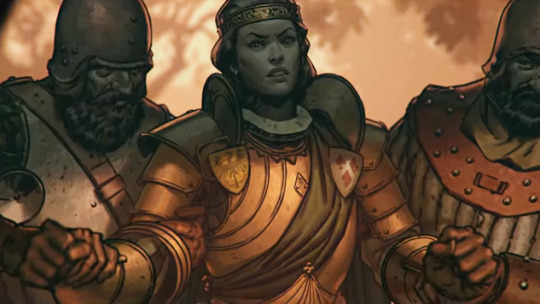
That’s not to say that the game encourages you to make the selfish choice. I’ve heard it claimed before that the Witcher games reward policies of non-interference and cynicism in the face of injustice, but I don’t think that’s necessarily true. Sure, taking the gold for myself would have made the game a little bit easier for me, but that’s temptation, not reward. There’s always a cost for getting involved, but it’s hard for me to see that as the game punishing me. There are consequences no matter what, and this is the rare game with a semblance of a morality system that often makes attempts at doing the right thing the most narratively interesting choice rather than the choice with the most practical reward. This becomes clear in the second chapter, where, after seeing the atrocities wrought by the opposition, you can’t help but become more willing to recognize the cruelty in yourself, to make decisions you never figured you’d make. This wouldn’t feel nearly as impactful if you didn’t start out trying to make Meve the most just ruler possible.
Though the game presents a complex world of bitter division and desperate cynicism, and thus engaging with it leaves little possibility of not getting blood on your hands, the writing rarely feels ignorant of the roots of injustice. The human lands that you spend most of the game exploring are deeply racist. The Elder Races - elves and dwarves, mostly, have been subject to countless pogroms across these lands, and even when they aren’t being straight up murdered, are never treated as equals to their human neighbors. So the fact that the Scoia’tael, a radical group of nonhuman guerillas, exist isn’t surprising, nor can you not have sympathy for their alliance with the invading Nilfgaard. Though the Nilfgaardians can be seen as a stand-in for any massive imperial force, from the Roman Empire to Nazi Germany, with all the delusions of racial superiority that tend to go with empire, their invasion of the Northern Kingdoms actually does seem to make life a bit easier for nonhumans - one of the chief complaints of the humans you meet living under occupation is how many more rights have been granted to elves and dwarves.
The Scoia’tael, fighting for Nilfgaard, thus become another enemy you must face. Some of them, justifiably thrilled at the prospect of overthrowing their oppressors, use the destruction of a kingdom like Aedirn as an opportunity to slaughter whole villages of humans as revenge. You see the mindless violence they’ve committed, then are faced with the threat of it yourself, and there’s really no other choice but to take the Scoia’tael down. It feels terrible. Every aspect of it. And I believe the game earns this trudge through moral quicksand. It recognizes the righteousness of the Scoia’tael, even as it forces you into opposition against them. It’s both awful, and a surprising relief from the social commentary video games so often fall into - the reductive and mischaracterizing Bethesda/Rockstar/Bioshock “both sides suck” approach. It recognizes the power differences at the root of the issue, and doesn’t hide from the ugliness that ensues.
That’s not to say that the writing is always perfect when dealing with this stuff. Cut a single corner with material this volatile and you can end up with a pretty off-putting scene, as Thronebreaker occasionally does. There’s one character, a human named Black Rayla, that joins your team in the second chapter. She’s a seasoned fighter of the Scoia’tel, and thoroughly racist as a result, and yet, she’s useful to your cause, so you allow her in. This is all well and good, and theoretically should make for some interesting internal conflicts, but there were several scenes where I was disturbed by Meve’s lack of response to Rayla’s nationalist bullshit. There was one scene where she was going down some real “I don’t have a problem with them, as long as they know their place” garbage, and I just decided to dismiss her at that point. I wonder what would happen if she stayed with my group till the end, if Meve would have more to say to her after she wasn’t quite as desperate for her help. I’d hope so, but considering the lack of mindful writing around her character I witnessed it, I wouldn’t exactly expect it.
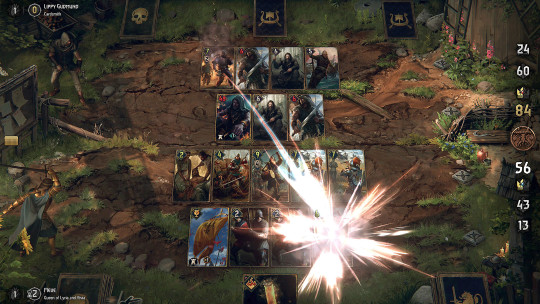
For as fascinating as the narrative of this game is, the thing you’ll probably spend the majority of the game doing is playing Gwent, and for a solid two-thirds of my time with the card combat, that was something I was very happy to be doing. The system built for this game, similar to, but modified from its Witcher 3 iteration, is deep, strategic, and occasionally pretty challenging. It feels made for newcomers like myself, mostly unfamiliar with Gwent, or even the standard mechanics shared by most card games, in the way that it eases the player into it. The first hour or so of the game is the official tutorial, but really the whole first chapter feels like a fairly natural extended tutorial for beginners, starting you off with a fairly limited deck in order to solidify the basics. For the most part this is very well done, though there were some particular aspects of the game that didn’t seem to be entirely explained, and took me a pretty long time to pick up on exactly how they worked.
The biggest strength that the card game here boasts is real variety. So many of the battles have particular rules or cards in play that drastically change the way you have to approach your strategy. Many of these come in the form of “puzzles” - aptly titled special battles where you’re given a specific set of cards and there’s really only one solution that you have to deduce through experimentation and logic. These are largely fantastic, not only because they’re all unique and fun in their own right, but because they often serve as mini-lessons in how individual units work and the various strategic ways they can be utilized.

Then there are the standard battles, where you actually get to shuffle and draw your own deck. The designers clearly put a lot of effort into the variety here as well, so often do they throw in inventive special rules and objectives, a lot of which not only change the pace of battle in meaningful ways, but often weave narrative significance into play as well. One of my favorite feelings in this game was getting stuck on a battle because of its particular rules, banging my head against it for a little while, then just suddenly seeing it, and pulling a satisfying victory just before it would’ve started feeling frustrating.
For as much thought and care as was clearly put into the design, though, there’s really only so many ways to keep combat interesting and engaging through a campaign that can last as long as fifty hours. In the back half of the game, combat can too often feel like a grind. At this point, you’ve got a big, diverse deck with plenty of powerful cards that makes it too easy to brute force your way through most situations. I found myself repeating the same tried and true tactics over and over again to bring my game to a speedy end so I could just move on with the story, which I was still very much enjoying. It’s hard to know if more work could have been put in to truly keep the card game feeling novel - Gwent just generally loses its depth once you’ve got mastery over a sturdy deck. I think ultimately, the game is just too long - possibly by even as much as ten hours or so, honestly. That’s not to say that I outright stopped enjoying it at any point; this is unquestionably one of my favorite games of the year, but if I didn’t have to face that grind in the final couple chapters, it very well could have been a contender for the top spot.
It feels a bit too long in the narrative sense as well. Not necessarily the written aspect of the narrative - that all felt consistently strong and inspired throughout the course of this game. But the mechanics surrounding the narrative, in particular the hard decisions you have to make as a result of limited resources, fall flat once the in-game economy feels maxed out. By the final chapter, all my upgrade trees were completely filled and I found myself sitting on a growing surplus of funds, and suddenly making the “right” decision didn’t feel quite as hard.

Despite its cumbersome length, few games surprised and enchanted me this year as much as Thronebreaker. The challenging and compelling role playing, the satisfying card combat...hell, even if that stuff wasn’t as outstanding as it is, I probably would have been happy to spend a considerable amount of time in it for its art style and music alone, so thoroughly did it soak me in those intoxicating Witcher vibes. It made me very excited at the potential CD Projekt Red still has in it for finding innovative and novel approaches to fresh storytelling in a well-worn universe, and I just hope that potential can continue to be realized after the distressingly muted reaction to this game’s release. Here’s hoping that its recent addition to Steam, and its upcoming console release, allows it to find the audience that it deserves.
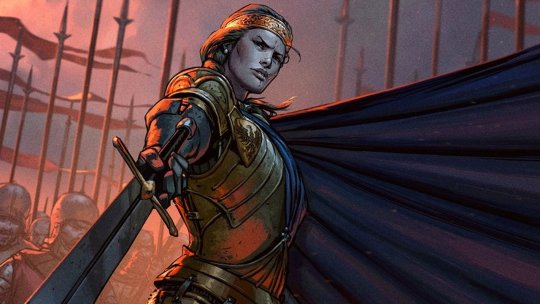
#Thronebreaker: The Witcher Tales#Thronebreaker#The Witcher#Witcher#CD Projekt Red#Cyberpunk 2077#RPG#Role Playing Game#Card#Cards#CCG#DCCG#Collectible Card Game#Digital Collectible Card Game#Review#Criticism#Podcast#Video Games#Politics#Games
54 notes
·
View notes
Text
Rockstar’s stumble into the frontier of games mirrors the ambition and exploitation in American expansion (a Red Dead Redemption review)

A little over halfway through Red Dead Redemption 2, our morally confused playable protagonist, the outlaw Arthur Morgan, meets a couple Native American men, two characters who become integral to the main story in the latter part of the game. Their tribe is given no name. Uncharacteristic horns ring at their introduction, providing a fanfare for the vaguely indigenous-sounding music that overtakes the score every time a mission for one of these characters is played. They lament their plight to Arthur, that the US government is once again breaking a treaty they’ve made with these people, displacing them from their land to extract oil. When they ask Arthur for his help, this white man responds with indignation: “There’s a price on my head in two states, my friend. The government doesn’t like me any more than it does you. Like you, I’ve been running for as long as I can remember...and like you, my time here is nigh on done.”
It’s an exemplar of the type of false equivalencies and hollow platitudes about the freedom of nature and the oppression of institutions that the game, like its predecessor, makes an overt thesis out of. What keeps it from falling completely apart is the fact that it basically makes sense that Arthur would believe it to be true: we’re not given many concrete details about his upbringing, but we know that it was rough, that most of his blood relatives are dead, and that Dutch Van Der Linde, the sociopathically charming leader of his gang, acts as a father figure to him and many other young members, people that Arthur considers family. He was raised as an outlaw, and owes his life to his gang, so it makes sense that Arthur never had much of an opportunity to recognize his privilege in comparison to, say, native folks. The problem is, the game doesn’t recognize Arthur’s bullshit any more than he himself does.

Over and over throughout this game, Arthur or other members of the Van Der Linde gang voice beguiling lamentations about the encroachment of society on the West in the year 1899, how, as Rob Zacny at Waypoint recently pointed out in a letter, the world just doesn’t have a use for these people any more, as if the world ever had a use for murderous bandits with no loyalties to anyone but themselves. We’re meant, it seems, to take all this eulogizing at face value, and to feel legitimate sympathy for these characters.
What’s shocking is that it actually, almost, works. Halfway, at least. Despite the derivative, hamfisted, and cynical writing that Rockstar Games has always built their narratives off of, all of which is toned-down but ever present in their most recent release, Red Dead Redemption 2 nevertheless manages to create a memorable and likeable cast of characters, whose personalities get deeply mined through the game’s excessive run time, who feel more fully realized and complex the more time I spend with them, who I can’t help but empathize with. And this, really, is fairly indicative of how I feel about most aspects of the game: it’s a mess, but an oddly endearing one.
--
Has Rockstar ever made an actually good game? I know that in part, that question is frustrated provocation on my part, considering how wildly successful, both critically and financially, each of their games has been, and how influential and groundbreaking to modern AAA game design. But I do ask it sincerely. Their games have always felt at odds with themselves, torn between their open-ended, stunningly detailed and endlessly playful world design, and the stiffly choreographed gameplay their genre-film-aping narratives ultimately force the player into. These narratives often have little to add to the much more nuanced films that they crib from, outside of an unpalatable libertarian cynicism that wields bitter but unfocused satire against just about everything and everyone within the game, the Housers and their writing team often seemingly knowing of no other form of fictive expression. Adding to that, the vehicle for these narratives often boils down to little more than mindless graphic violence, each mission ending up at wrestling with swimmy controls while performing repetitive shooting and/or reckless driving.
When I was a teenager and playing games like Grand Theft Auto: San Andreas, my dad often derided the way I played as “not actually playing the game,” apparently dismissing the creative fun I found in poking around the game’s opulent sandbox rather than engaging in the game’s main story missions, which I found more of a tedious necessity in order to open up more parts of the map rather than the main draw of the game or the “way it’s meant to be played.” What he didn’t understand, probably because he never played the games himself, is how much more the world of Rockstar games has to offer than the story missions do. The budget and talent that Rockstar can afford make for some of the most stunningly and exhaustingly intricate open worlds in video games. While I can’t actually speak for the inner dynamics of how these games are designed, it’s always seemed to me that there’s the aspect of the games that Dan Houser and his creative leads focus on, which is the main narrative, and then there’s the actually impressive aspect, the awe-inspiring collective effort of a large team of immensely talented and frequently overworked designers to produce a convincingly living, breathing world that the player can find herself immersed in.
In many ways, RDR2 follows in that same tradition of all previous Rockstar games, first and foremost with the labor abuses committed throughout its production. All of this is well-documented at this point, from the prior knowledge that we had about Rockstar, such as reporting of egregious crunch schedules maintained by employees by their spouses way back around the release of the first Red Dead Redemption in 2010, to Dan Houser’s interview with Vulture prior to the release of this game, in which he casually bragged about 100-hour work weeks, to the exposé that Kotaku’s Jason Schreier released soon after that, detailing various stories of Rockstar’s crunch culture by dozens of current and former employees. Rockstar certainly isn’t the only developer taking advantage of their employees’ passion for their work, and in a way it feels like an odd sort of power to play a game knowing just how bad the labor conditions were. It’s easier facing the realities of the way something was made going into it rather than retroactively, and there were very few moments in my time playing this game where I wasn’t thinking, at least in the back of my mind, about the amount of pressured overtime any given employee had to put in to make the experience that I was having the experience that it was.
It’s hard not to think of this when Schreier started off his massive piece with the story of the late-in-production addition of widescreen black bars during cutscenes, which required massive amounts of crunch within the final year of production to retool the game’s hours of scripted sequences, all in an attempt to make it feel more “cinematic.” Every time I enter a mission, those black bars appear, a stark reminder of the mindset of Rockstar creative leadership. Seriously, fuck those black bars. It’s not just that, as was discussed in a recent episode of Waypoint Radio, it feels like such a sophomoric, pretentious notion of what makes something cinematic, rather than, say, actually thoughtful and meaningful cinematographic choices. It’s also that it was so clearly a rushed add-on that it sometimes doesn’t even work correctly. I lost a solid hour and a half trudging multiple times through a particularly long and slow mission due to a glitch at the end of it, in which those bars refused to go away and trapped me in post-cutscene purgatory several times over, until I finally decided to skip the cutscene altogether. To answer a question Schreier rhetorically asks in his article: no, the black bars were definitely not worth it.

And they’re not the only obvious example of this game’s excesses with blatant disregard for the worth of employee time and energy. Without giving too much away, there’s a section of this game that takes place away from the already massive, staggeringly elaborate main map. From the foliage to the architecture of the environment, it’s obvious that this isolated section is no rework of prior assets that make up the rest of the game (in fact, pretty much no part of the map feels at all copied and pasted from another), but a ground-up, brand-new environment. And it’s so completely unnecessary. The plot drags unbelievably in this section, beating the player over the head with the same repetition of themes and character arcs that already felt played out a dozen hours ago by that point. The gameplay is reduced to the least compelling version of the game possible, a several-hour-long shooting gallery that outdoes any feeling of fatigue I’ve ever experienced toward the end of an Uncharted game. I nearly put the controller down for good in this part, not just out of boredom and frustration on my end, but out of sheer outrage at what a costly and laborious process it must have been to create this section that fucking sucks.
The excess that created that absolute slog of section of the game is decidedly distinct from the detail-focused world design that always pulled me back in, no matter how much I was struggling with the game’s narrative. Few game worlds I’ve inhabited have been anywhere near as evocative as RDR2’s. The design isn’t merely a technical achievement, but an artistic one, that at best conveys a focused minimalism despite its obvious ostentatiousness. As a point of comparison, I’ll use another critically acclaimed AAA game from this year that I’ve at times struggled to enjoy: God of War. Both of these games are undeniably gorgeous: meticulously sculpted, bright, colorful, dynamic worlds. Any given frame from one of these games makes for a very pretty picture. But despite its jaw-dropping fidelity, God of War lacks a certain atmosphere: it usually feels like I’m looking at, rather than inhabiting, the game.
Red Dead Redemption 2, on the other hand, touts atmosphere as its main draw. When you’re on the plains near the small town of Valentine, and clouds roll in, the wind picks up, particulates, leaves, and grass start swirling and blowing around you, and finally, rain starts pouring, it’s difficult not to get a chill, to just nearly feel the drop in temperature, the breeze, the precipitation. You want, suddenly, desperately, to get into town, to shelter yourself from the harshness of nature. The ride is long, and difficult, and the storm has passed by the time that you actually arrive in Valentine. The game doesn’t have to account for this - as far as the game is concerned, it could have not been raining at all anywhere that you weren’t, and yet, when you ride in, you can see water dripping from the wooden roofs, and it’s clear that the storm touched this town too. It’s enough to still feel the dampness on your clothes. You head to the nearest saloon, to get a drink and a meal, maybe even a hot bath, and warm yourself up. Camp is a bit of a ride out of town, so you decide to bunk at the local hotel, and head back to the gang in the morning, when hopefully it’s a little more habitable outside.

The realism with which this game is rendered encourages this kind of role-playing, even if it doesn’t necessarily require it. This is a smart design move. There are light survival mechanics to this game, some of which almost feel like an extension of some of Rockstar’s experimentation in the aforementioned San Andreas. You can eat, which is necessary to refilling your health, stamina, and dead eye cores. Eating too much or too little can render you overweight or underweight. You can also sleep, which likewise refills some meters, and encourages hair growth. You can cut your hair and beard in plenty of different styles, but unlike previous Rockstar games, once you cut it, you’ll have to wait for it to grow out again. Hunting, fishing, and gathering play a part in this game, not only in collecting edible or craftable resources for yourself, but for your camp as well.
And yet, very little of this is required, and this leniency actually facilitates the fun of the roleplaying rather than enforcing it and making it another tedious system to engage with. Sometimes I spent a lot of time around camp, hanging out and talking with the bunch of misfits that constitute Arthur’s family, both engaging in conversations and observing incidental dialogue and animations. The seemingly endless interactions these characters play out together gives the impression that they are really living here, whether or not you’re around. I’m not sure if I’ve ever seen such a complex and realistic depiction of a small community in a video game. 50 or so hours in, I was still recognizing subtle but thoughtful mannerisms, relationship dynamics, and developments that I hadn’t yet observed. It highlights the great character work this game employs better than any of its many cutscenes.
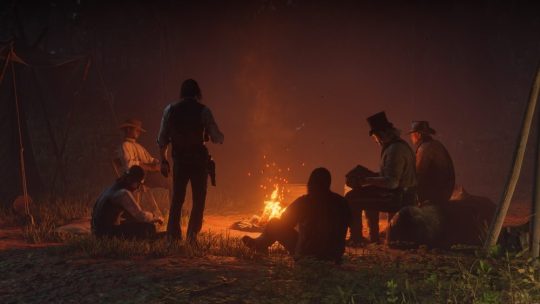
When I felt like it, I’d sleep in camp, going to bed at night just like most of the gang regularly did, going out to town for a short mission or simply just exploring the surrounding environment, inhabiting Arthur’s shoes as best as the game would allow me to. Other times, I was more focused on moving the story forward, and the game offered no complaint - you don’t have to sleep, or eat more than is necessary to heal, or hunt. In fact, I rarely hunted throughout the game at all, finding it more irksome than it was worth, and the game seemed fine with this. The ability to pick and choose which parts of, and to what degree, you interact with this world is one of the game’s most successful achievements.
This level of interactivity is, nevertheless, a huge part of what makes this game as fascinating as it is to me. As I stated earlier, most previous Rockstar games boil down to mechanics as simple and limited as shoot, run, and ride. To be clear, there’s plenty of all of that in RDR2, and at times, a similar excess of it as in any other game Rockstar has put out. If you’re not pulling your hair out at the prospect of yet another shooting gallery mission by the time Chapter 6 rolls around, we probably have fundamentally different ideas of what makes games fun. But in addition to those basic verbs, this game offers plenty more. Any NPC can be talked to by either greeting or antagonizing them. Usually this results in little more than a short, simple exchange, but sometimes side stories develop in surprising ways from just interacting with the people around you. Some of these stories are scripted, and some of them are your own to make, just as your level of roleplaying is left up to you.
The best missions involve some sort of process or mechanic that Arthur engages in. It doesn’t have to be a complex, or even particularly well executed process in order for it to be effective. Whether it’s holding down a trigger to pour moonshine on a bunch of crops with plans to light them up, alternating button presses in order to lower a crate of dynamite carefully under a bridge, performing ranch hand chores like milking cows, cleaning stalls, and building fences, or the hilariously several-stepped process of pouring shot after shot for a bar of thirsty yokels, this game thrives in the details of making Arthur interact with the world. It’s remarkable that for a game that objectively controls badly, leading to Arthur or your horse frequently committing actions you had no intention of them committing, something as simple as a button press can be satisfying or possibly even profound when the effect is experiential, allowing you to interact with the game world in ways you had never considered before. It’s no surprise that this is the first game I’ve actually enjoyed the fishing minigame in, so focused is it on finding joy and reflection in simple, practical tasks, especially ones undertaken with a partner or a group.
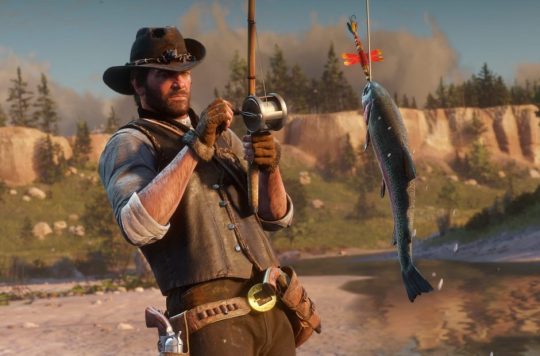
There’s a very late-game mission that involves building a house. Before you actually begin to build it, you purchase all the pre-fab materials, a relatively new concept at the time this game takes place, which the characters are all a bit wowed by. What follows is a long, interactive montage in which you lay a foundation, build the frame, add roofing, etc. all to a goofy, likeable country western song, and at the end of your project, celebrate your accomplishment with your friends. I could play an entire game around this, a game that explores historical context through average, working people engaging in ostensibly banal but uniquely fulfilling work. How much more interesting and engaging that would be than the awkward, clumsy cover shooter RDR2 too often is. I wish this section were longer, and more in depth, giving me more control over the construction than some basic button prompts. It made me yearn for a Harvest Moon or a Stardew Valley made with Rockstar’s budget. Imagine the potential for historical or communal immersion in a game like that!
The game also allows for player agency in choosing just how villainous of an outlaw Arthur is. As a general principle, the Van Der Linde gang considers themselves to be a bit more morally conscious that your average group of bandits. Yes, they steal and kill, but only from those that could really probably use some stealing and killing. They’re not Robin Hoods, exactly, but are guided by some similar directives. Of course, the player learns pretty quickly in that these directives are more aspirational than practical at best, or barely-concealed bullshit at worst. Before the game even begins, the gang is on the run from the Pinkertons for a robbery gone wrong, in which Dutch killed an innocent woman, something that is described with shock by Arthur as something highly uncharacteristic for him. As the game progresses, the player isn’t given much evidence that cruel brutality and reckless violence is anything but entirely characteristic for Dutch, no matter how many high ideals he espouses.
The various members of the gang, likewise, run the gamut from respectable to despicable, including Arthur, depending on the way you play him. The game employs a fairly dated feeling Honor meter pulled straight from a mid-2000’s Bioware game in which Arthur’s general deeds are judged - do you spare people when given a choice, help people in need, and act generally friendly, or do you murder and steal indiscriminately? This is an easier mechanic to pull of in a Bioware or Bethesda game in which the player character has few defining characteristics, but Arthur has a very distinct personality, due in part to the writing and even larger part the admirable performance by voice actor Roger Clark, which imbues Arthur with much needed nuance and empathy. Depending on the way you play him, the Arthur you see in cutscenes may feel disorientingly disassociated from the Arthur that you control.
As far as the story goes, Arthur would probably be somewhere in the middle of the meter in the first few chapters, slowly working his way up as the game progresses. So if you’re playing him as particularly villainous, your deeds may feel increasingly incompatible with his story arc, whereas if, like me, you’re going more the “Paragon” route, it might take a while before cutscene Arthur becomes the man who’d suck the venom out of a stranger’s snake bite or risk his life to save a woman from attackers, as you’ve done in the introductory sections of the game. It’s an odd choice to give the player such potentially mischaracterizing agency, and there are a few missions in the final chapter that actually do give you morally defining ways of choosing to play out a mission that I wish the rest of the game had.
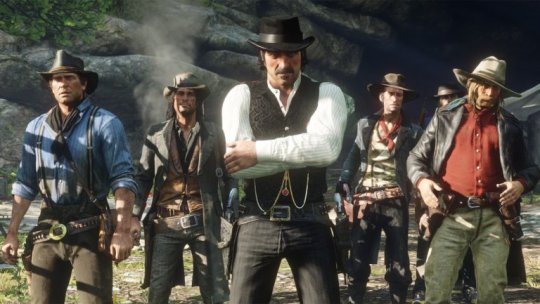
Dutch’s downward spiral, in which he consistently has to rally his gang into buying whatever new rash and desperate plan he’s recently cooked up, while his actions become more unpredictable and his personality more toxic, poisoning relationships and sowing distrust among the gang, makes for a large part of the game’s long story. Like, a very large part. A uselessly, almost hilariously monotonous part. I just summarized the whole conflict in one sentence. It was probably a slightly awkward and overlong sentence, but still. One sentence. And yet, the game devotes dozens of story hours to reinforcing this idea, just in case you didn’t quite catch what was already painfully obvious in the first dozen. Dialogue becomes increasingly repetitive as characters run through the same motions over and over again in slightly different settings and contexts, explaining the already perfectly comprehensible story in painfully explicitly detail. It’s honestly hard to think of another piece of media that so blatantly disrespects the player’s time, patience, and capacity for comprehending subtle storytelling.
What attempts Rockstar does make in telling a more thoughtful and empathetic story than in previous games are often awkward and basic, but they do resemble progress, I guess. Take, for example, a mission in which Arthur escorts a young woman to a suffrage rally in a rural Southern town, at the behest of her lover, who worries for her life at such an event. You meet the leader of this group of suffragettes, who explains basic human equality in democracy to a mostly-on-board Arthur. Previous Rockstar games probably would have injected some signature Houser cynicism, revealing this woman to be a hypocrite in some way. But it’s 2018 and Rockstar are Serious Storytellers now, so they avoid any over-easy digs, but what remains is very little in way of meaningful characterization. All that we’re left with is a vague suggestion that we’re not meant to take her entirely seriously, even if we’re not exactly sure why. It’s as if they intended to put a punchline in there, got nervous about it and took it out, but failed to add anything else.
Okay, I guess that’s a bad example of progress, but it is fairly representative of where some significant sections of this game are in their storytelling. There are plenty of parts of this game, though, where the writing team drops the vague air of satire to tell a straightforward, but affecting tale. There’s an unexpected development that occurs toward the end of the fifth chapter, for example, that massively impacts Arthur’s arc throughout the rest of the game. This arc isn’t just represented in the main story, but in a few optional side missions as well, missions that are very worth seeking out. In these, Arthur reflects on, and attempts to reckon with, despicable deeds that you help him commit toward the beginning of the game, deeds that he not only has practical reasons for regretting, but is very obviously morally haunted by. The way that he attempts to navigate the ramifications of his own retribution, attempting to right some wrongs, all the while knowing he’s well past forgiveness or reconciliation, took me by surprise.
It’s true that even when the game does successfully pull ideas like this off, the tedium of the larger story and repetitive gameplay threaten to lessen the impact. After the game’s climax at the end of its final numbered chapter, for example, you’re launched straight into an audaciously extended epilogue that adds another six or so hours to the story before you’re truly finished with it. Some missions in this epilogue are actually some of my favorite in the whole game, and some are standard and unnecessary. But even as good as some of it was, it was hard for me to get that excited about it, feeling so burnt out by the already overstuffed main story as I was.

--
I started out this review with the claim that Red Dead Redemption 2 is a deeply flawed and frustrating game, but also a special and endearing one. Looking back, I feel like I’ve successfully demonstrated the former, but may have failed to truly highlight the latter. I think this is true to the feeling this game left me with, honestly. Considering the steady increase of vexation I felt the more I played through this overlong thing, it’s honestly a hard game for me to recommend. There are already plenty of reviews touting RDR2 as game of the year, so I feel plenty comfortable in making mine a warning about devoting one’s precious time to a game so frequently happy to waste it.
I’ve even wrestled with my own regret at pouring as much time as I did into this game. But I know that if I wasn’t actually deeply enjoying very important parts of this game, I would have just put the controller down hours ago. It’s a game where I can feel utter exasperation with the last mission I did, then once it's over, go riding out into the wild to find something new I've never discovered before, tinkering with my options to see just how much the design team accounted for various minute choices, or spend some time hanging out with the folks I feel I've really come to know and love at camp, or simply just exist in this spectacularly rendered world, and suddenly I’m back in. There’s even an occasionally great story here, though you do have to dig for it.
There are things that this game does, from its evocative and atmospheric world design, to the interactive theater of the camp, to its obsession with detail and process, that I’ve wanted to see done in a game for as long as I can remember. These are game elements that I hope other developers see the potential in, because I think there are moments of this thing that show me exactly where I want games to go in their interactivity and immersion. Since it’s all still fresh in my mind, I really don’t know what aspects of this game are going to stick with me. Maybe I’ll look back and not see much more than frustration at wasted potential and exploited labor. But I hope that those parts that so inspired me continue to do so, because there’s something powerful and important out here on the frontier (of game development), a wildness and freedom that hasn’t yet been captured and tamed (by focus-tested, lowest-common-denominator AAA design), that’s not always pretty, but is more often than not admirable in its intrepid ambition; at least, until you think of the human price paid to realize such ambition.
#Red Dead Redemption 2#Rockstar Games#Rockstar#RDR2#Grand Theft Auto#GTA#open-world#open world game#sandbox#video games#video game#game#gaming#game development#AAA#God of War#America#History#criticism#critic#review#podcast#Waypoint#Waypoint Radio#action#western
3 notes
·
View notes
Text
‘Ni No Kuni II' Fights Fire with Friendliness
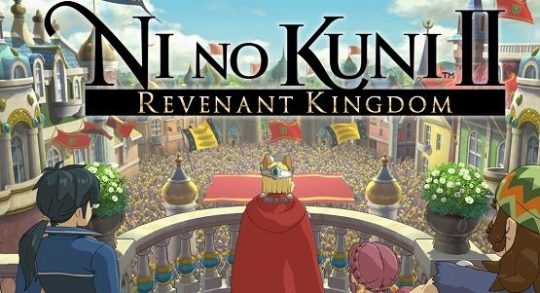
I played the final chapter of Ni No Kuni II: Revenant Kingdom hours after President Trump, a world leader cartoonish, short-sighted, and petty enough to fit fairly inconspicuously among the cast of villains in this storybook JRPG, announced and carried out an airstrike on Syria. As our country resigned itself to add fuel to the fire of one of the worst humanitarian crises in modern history, and risked upsetting its already tenuous relationship with other powerful nations, I helped the cat-eared boy king, Evan Pettiwhisker Tildrum, and his gang of eternal optimists, fulfill his mission of uniting the world under the banner of peace and happiness ever after.
As with many moments of this game, it should have felt cheap. To reduce the world’s ever-complicating and deepening evils of poverty, war, and power to something that can be resolved by the good-natured idealism of youth and a bit of combat that feels hardly more violent than a schoolyard scrap. And yet, I was moved. And it wasn’t the first time. This is a game that regularly turns saccharin, unrealistically tidy storytelling into genuinely affecting moments: moments that feel significant not just for their heart but almost urgently vital in their message. In our politically tumultuous age, where the burdens of inequity and violence feel heavy enough that predicting humanity’s imminent demise has become commonplace, Revenant Kingdom offers a balm equally aggressive in its dedication to locate and cultivate the goodness in everyone: the more ostensibly villainous the person in question, the more powerful the eventual redemption.
Since the game was obviously in production for a number of years, it’s unlikely the creators predicted our current placement on the doomsday clock at two minutes to midnight in the year it was released, but the opening scene begins with the collective nightmare scenario of 2018: the nuclear destruction of a city that looks conspicuously like New York. The president of this unnamed country, Roland Crane, is driving into the city as the detonation occurs, and he only has moments to witness the annihilation of his home and his people before he finds himself transported to a fantastical land, in the private chambers of the newly annointed young King Evan. After only moments of confusion, Roland seems to embrace the escape afforded by this mysterious event, helping Evan flee his own kingdom after his late father’s duplicitous advisor, Mausigner, stages a coup.
For long stretches of the game, Roland rarely mentions his destroyed homeland, but it’s a powerful enough opening image that the game doesn’t need to continually remind us of it - we know that Roland’s thoughts and actions must stem from his recent trauma, regardless of how shockingly good he is at hiding it. That image never left my mind during my roughly forty hours of play through Revenant Kingdom’s otherwise beautiful, charming, and whimsical world of entertainingly accented anthropomorphic denizens, just as it never leaves Roland’s. It’s an audaciously memorable way to stage the game’s ambitious anti-war themes.
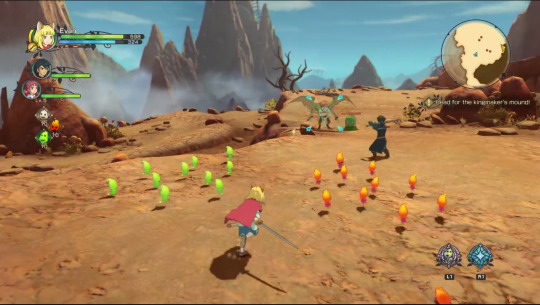
It’s also a sharp departure from the decidedly more personal story of the games predecessor, Ni No Kuni: Wrath of the White Witch. While that game, Level-5’s agreeable collaboration with Studio Ghibli, began with a similarly traumatic event - the death of the protagonist's mother - the stakes felt decidedly smaller. With Ghibli out of the picture this go around, Level-5 has maintained the original’s gorgeous, anime-inspired cell-shaded art style, and Joe Hisaishi once again turns in a fantastic score, but despite these aesthetic similarites, the gameplay of Revenant Kingdom is largely unrecognizable from its predecessor.
While White Witch had fairly standard turn-based, Pokemon-style combat, Revenant Kingdom is more action oriented, in the vain of something like Kingdom Hearts. Inventing combos of light and heavy attacks is fun enough, but the simple hacking and slashing at the heart of combat is complicated and balanced by a number of other systems, including dodging/rolling/jumping, “Higgledies” (little Pikmin-esque creatures that grant certain powers and spells during combat), and most importantly, the “Zing” effect. Every character can switch between three weapons freely during combat, each of which builds up a meter. Once that meter reaches 100%, that character can unleash a special move, anything from a devastating physical attack to an elemental spell. Keeping the Zing cycle going through combat is an actively engaging juggle, something that makes for rarely stale or repetitive combat. It helps that, also unlike White Witch, this game keeps grinding at a minimum, a trait that in comparison to most JRPGs feels surprisingly generous.

After Evan is ousted from his throne, he settles down in a relatively unoccupied territory where he builds a new kingdom from the ground up, which he names Evermore. This conceit introduces two other brand new systems that Revenant Kingdom employs, to varying degrees of success. One is a military combat mini-game called Skirmish battle, in which the player controls squads of soldiers as they face down enemy armies, such as rogue bandits intent on stealing his land. The combat here is automatic, with soldiers engaging each other on their own as soon as they’re close enough. Where the player comes in is in positioning and morale boosting - there’s a rock, paper scissors system in which sworded soldiers can easily best axed soldiers, axed soldiers beat speared, and spears beat swords. The player rotates these squads in positions that are most efficient, all the while ordering them to charge and defend at opportune moments. It’s a simple system, one that’s hardly a pain to engage with, and yet one I was rarely happy to have to do. There’s too little control over soldiers to make it much more than a mindless exercise, and there are sharp spikes in enemy levels that mean if you’re trying to complete all the side quests involving Skirmishes, you’ll have to do a decent amount of grinding. Thankfully, this is largely optional, and though you do have to be a certain level to complete sections of the main game, it never feels like too much.
What felt more at odds with my enjoyment in this system, though, outside of its exact mechanics, is its language and presentation, which just doesn’t seem to match the whole spirit of the game. Evan builds Evermore in the name of world peace - he wants to end war by bringing all nations of the world together. And yet, part of the game has him doing this by engaging in actual battle. The regular combat system feels more excusable for this, as you’re mostly fighting actual monsters or robots, and it feels primarily in the name of defense rather than offense. But that Evan is building a standing army of soldiers to wage war seems antithetical to the rest of the game. Even though it’s generally presented in a cutesy way, using the chibi character designs of the overworld, it’s a bit hard to reconcile.
One can similarly lob these criticisms at the very fact he maintains a monarchical structure in Evermore, but this is where the other new game system comes into play, which feels decidedly more thought out. The player gets to help build Evan’s new kingdom in a manner that doesn’t feel entirely removed from Metal Gear Solid V’s Mother Base building. You build new structures around the kingdom, from shops that help you develop new weapons, armor, spells and Higgledies, to bazaars, lumber yards, farms, and other services that earn you various resources, which can help with both crafting and with completing the game’s many side quests. To manage these places, you select citizens of your kingdom that are particularly suited to the task at hand. Engaging with the multiple menus of managing Evermore isn’t always fun - there’s a lack of intuitiveness in the layout that makes certain tasks more tedious and time consuming than they really ought to be. I hope that this is the kind of quality-of-life issue that could be fairly easily fixed in subsequent patches.

Citizens join your kingdom when you complete side quests, which usually involve doing some sort of favor for them before they agree to pack up and move. There can be a certain lack of imagination in the player tasks for side quests, which too often involve simple fetch or delivery quests. And yet, side quests are compelling for a number of reasons. First is that every time you gain a new citizen, it feels like a legitimate reward that allows you to move forward with a new project in Evermore. And between quick load times, multitudinous fast travel points scattered around the world map, and an airship that can get you just about anywhere within mere seconds, the pacing of these quests feels appropriately zippy in relation to the task at hand. It’s not difficult to knock out half a dozen side quests in the course of an hour, a time investment that feels more than worth the effort.
But most importantly, these quests allow you to engage with your subjects in a way that fascinatingly subverts the inherent power dynamics of your respective positions. No task is too small or demeaning for King Evan. Even when it feels like he really should have more important things to do, he faces delivering love letters or searching for missing personal items with the same enthusiasm and gravity of purpose as he does taking down a giant monster that threatens the safety of a city. This is a common discrepancy among open world games and RPGs such as this, the question of why someone burdened with such a weighty quest would waste his time helping someone with their menial, asinine shit. Rarely does this discrepancy feel so thoroughly justified as it does in Revenant Kingdom. Evan is a King that works for his people without a single thought as to what may or may not be beneath him. It’s not surprising that with such unwavering devotion, he so quickly gains such a strong following. Most of these many side characters are, in turn, funny and charming characters in their own right. Level-5 did an excellent job adding fun character and voice flourishes to the localization, and engaging in this dialogue is often its own reward, outside of whatever more tangible payments you receive.

Most of the main cast of characters outside is also well done, particularly Evan and Roland, but also the burly sky pirate Batu, who is a blast to control in combat with his giant axes and hammers, and his fierce daughter Tani. Some of the characters introduced in the latter half of the game feel a bit more like afterthoughts than the core group, but are all serviceable enough. A particularly delightful character is Evan’s Kingmaker, Lofty. All kings in this world are blessed with essentially the divine right to rule by virtue of the bonds they make with Kingmakers: towering, elegant beasts who grant their Kings with legitimacy and defend their kingdoms. Evan had one back in his home kingdom of Ding Dong Dell (just one of the many delightfully titled proper nouns to be enjoyed in this game), but once ousted, he has to go through a ceremony to get a new one for Evermore, and ends up with Lofty, a tiny, deformed-Lisa Simpson looking creature who speaks with a thick Welsh accent and the more universal dialect of sarcasm. His dialogue, like that of Drippy’s from the previous game, is one of Revenant Kingdom’s true joys.
Added to the mix is a cast of villains that make for fairly obvious, but overall successful social commentary. There’s a corrupt king who rigs the luck-based legal system of his government to ensure he always comes out on top, a secretive ruler who enforces draconian laws on her citizens, a tech-wizard CEO whose corporation has become so large it’s merged with the government and works its labor force to death, and most compellingly, Mausinger, the one who dethroned Evan. Being young and kept in the dark while he was at Ding Dong Dell, Evan was ignorant to the racial inequities of his kingdom, where humans and cat people forcibly kept economic and political power from mouse and rat people, which formed the basis for Mausinger’s coup. Evan’s reckoning with the evils of his home kingdom is one of the more fascinating story threads in the game, one I was pleasantly surprised to see delved into.
It’s one of the many moments where Revenant Kingdom eschews the black-and-white morality of most JRPGs, while nevertheless leaving questions of who the heroes are and who the villains are decidedly unambiguous. Goodness, the game implies, is the potential for improving, for recognizing one's mistakes, no matter how well-intentioned they may have been, and vowing to do better. This is a universal, all-powerful concept in the world of this game. It may be intentionally reductive, a childishly and fantastically simple solution to humanity’s history of injustice, but the message rings shockingly true. Maybe in a more nuanced age of history, that truthfulness might have felt just a bit hollow, but the bluntness of it lends it a quality that for 2018, feels critical. It’s the militantly good-willed, all-out assault of optimism that we could really all use right now.
8.7
#Ni No Kuni II: Revenant Kingdom#ni no kuni#video games#anime#JRPG#RPG#Open World#Politics#Donald Trump#pop culture#review#criticism#podcast#games
9 notes
·
View notes
Text
Diminishing returns are hard to notice in a game as good as Uncharted: The Lost Legacy

We’re now ten years removed from the year Naughty Dog released Uncharted: Drake’s Fortune, the first game in what would become a defining series for the previous console generation, and eight years removed from Uncharted 2: Among Thieves, the game that blew the collective mind of action game fans everywhere and cemented many of the narrative and gameplay elements that would dictate a whole genre then until now. You’d imagine that by now, a team as talented and innovative as Naughty Dog would have moved on to something completely new, as they seemed to suggest they were doing in 2013 with The Last of Us, one of my favorite games of all time, or that if they were still somehow making Uncharted games in 2017, that they would have lost all the luster the series once held. The fact that neither of those things is true, and that, in fact, the most recent two games in the series, released within nearly a year of each other, are hands down the best games the series has to offer, is something I’m still struggling to fully wrap my head around.
Uncharted 4 was by all rights an unnecessary game, a next-gen follow up that didn’t particularly feel mechanically removed from the ones before it, the third of which started to wear thin before it was even over. And yet, the incremental but significant improvements the game made - fully taking advantage of the stunning capabilities of the PS4’s hardware, adding stealth mechanics that allowed for variation and choice in gameplay, and, most importantly, integrating the lessons learned from The Last of Us to tell one of the most compelling and mature stories ever told in a video game - made Uncharted 4 one of the premier gaming experiences of the current generation. The newest game in the series, The Lost Legacy, was originally meant to be the DLC to Uncharted 4, but seemingly gained a life of its own in the production process, so much so that it turned into a full-length, stand-alone title, which is available at the really rather generous price of $40, or, free to those who bought the Season Pass to the previous game.
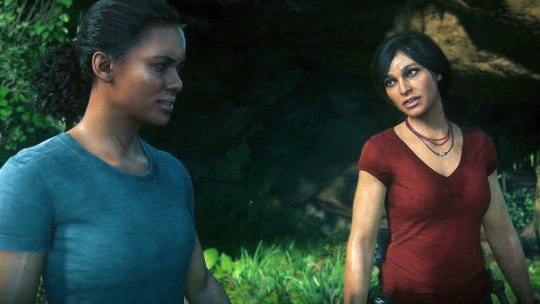
From the start, the most obvious change this game offers is that Nathan Drake, the dashingly manipulative protagonist of every previous game, is nowhere to be found, and in his place is Uncharted 2’s not-quite-femme-fatale Chloe Frazer, joined by Uncharted 4’s not-quite-villain Nadine Ross. If Uncharted 4 was the game to poke holes in Drake’s problematic charisma, The Lost Legacy is the game to finally retire him for good, making room for a couple of the series’ female characters, long relegated to the sidelines despite their well-rounded development, to truly shine in the leading role. The peak-of-the-medium storytelling Naughty Dog has made their signature for the last four years or so is as soulful and inspired as it’s ever been here, providing character depth and dynamics that are just about unparalleled in the industry: everything, from the directing to the acting to the writing, tied together by just about the most impressive use of motion capture in any video game, is wildly masterful to the point that it kind of just makes any other game aiming for similar fidelity nearly irrelevant.
As it turns out, the headstrong and sarcastic Chloe pretty easily fills any Drake-shaped holes the player may be tempted to see, but goes further than that, proving herself to have a compassionate and sincere soul underneath the quips and stubborn determination. The real magic of the story, regardless of the main plot, which expectedly involves a quest for lost artifact from some quasi-mythical forgotten city and a villain that’s trying to get to it first, is the relationship that builds between Chloe and Nadine. Nadine may have been on the opposite side of the Drake brothers in the previous game, but she always came across as a particularly level-headed mercenary hired by the true villain, and here we’re able to see her break down her stoic walls of professionalism as she becomes friends with her newest employer. The writing is strong, but just as before, the real MVP driving the story is the how beautifully the motion capture renders the performances. These characters can say so much without a single word through naturalistic facial expressions, and it’s not long into the game before one stops thinking of them as computer-rendered.

Like the last game, The Lost Legacy introduces a new element that serves to separate it from the rest of the games in the series: there’s actually an open world section. It only happens once, right in the middle. The first and last parts of the game unfold in the same linear fashion as every previous game does, but for the middle section, the player is given a large chunk of open land to drive around, replete with many of the defining traits of other open world games: you start by climbing a tower to get a lay for the land, and from there can tackle any of the story sequences in the order you wish; the area is also replete with enemy camps to raid and side item collecting that proves to be surprisingly quite compelling. Fully exploring this section can take a solid few hours, if you’re interested in more than just the main story, and I personally loved taking my time here.
The game remains rather mechanically simplistic here, and even the map is just an actual piece of paper one must pull out and look at in order to find one’s way and mark down new discoveries, so there’s a stripped down feeling of surveying to the whole sequence, allowing the series’ title to feel more relevant than ever. Plus, the more you explore, the more Chloe and Nadine chat, relegating some of the most insightful revelations about these characters to the absorbing sidelines. Given the relative minimalism of it all, I’m not sure how much I’d enjoy, say, a whole game based around it, but occurring where it does in a roughly ten hour game, it serves to break up the gameplay wonderfully.
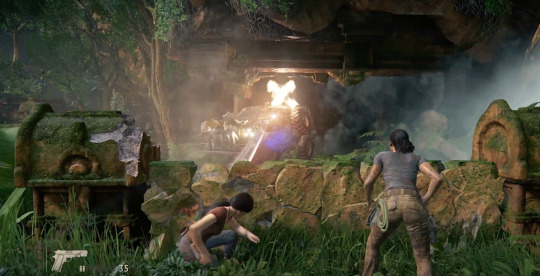
As for the rest of the game: well, it’s Uncharted. As shockingly strong as this game is, there’s a certain impact that just isn’t going to hit anymore. The wall-scaling and the gunplay that have always made up the bulk of these games is still there, and with that comes the Unchartedness that once was surprising and thrilling, but now feels expected almost to the point of feeling rote. There’s only so many times a structure can crumble just as you jump off it before that sinking feeling in your gut just doesn’t happen anymore. Some of the big action set pieces feel a little like stale rehashes of moments from previous games, even if they’re technically done better than ever before. For those who still feel burnt out from the last game, the prospect of incremental gameplay improvements and another beautifully crafted story may not feel like enough to make any of the standard Uncharted stuff feel any less underwhelming.
But for those like myself, who find it impossible to resist a lovingly built Naughty Dog game, that occasional feeling of deja vu isn’t particularly difficult to overcome. It’s a consistently gorgeous game with unparalleled character work, and gets the job done a lot faster than the previous game, which, for many, despite its achievements, overstayed its welcome by the end. As far as I know, this is Naughty Dog’s final foray into the universe of Uncharted, but it's a testament to this game’s enduring playability that at the end of it, I walked away thinking that for as long as they continue making these, I feel confident I’d stay a happy customer, no matter how increasingly unnecessary they may feel.
8.2
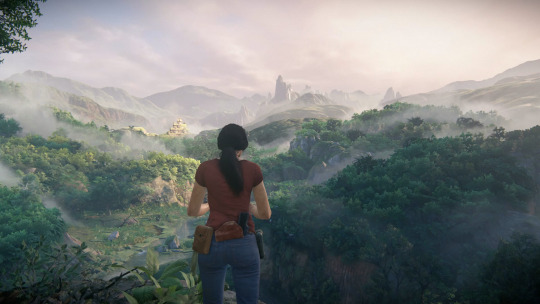
2 notes
·
View notes
Text
Tacoma is a lesser, but worthy, successor to Gone Home

Following up Gone Home was always going to be an impossible task. The particular nature of that game, coming out in the right place and the right time, was nothing short of a revelation for the video game world. It wasn’t just an exceptionally well done, tight little game, it also opened players’ minds to the kind of stories games can tell, and way in which they could tell them. Making another game in that vein, which, more or less, is exactly what Tacoma is, couldn’t help but feel like a slight letdown against the cultural touchstone Gone Home has become. That said, with Tacoma, the folks at Fullbright have once again created an engaging, refreshing narrative experience that ends quickly but rewards replay.
Considering the amount of time that this game has been in development, it would be hard to blame Fullbright for setting this game on a space station, a setting that’s popped up in a number of recent games, including one that I played a lot of, Prey. As a result, there’s a certain staleness that I couldn’t help but sense in the opening minutes of the game, getting ready to explore a space I felt like I’ve already explored a lot of lately. It went away quickly, though, as the story began to unfold to reveal a station with a lived-in feel to it, little idiosyncratic personal details scattered everywhere that reveal the characters who once occupied this space almost as well as the actual dialogue.
The player assumes the role of Amy Ferrier, tasked with the assignment of exploring this abandoned space station, collecting data from the station’s AI, and figuring out what the hell happened to everyone. The original occupants of the space station signed off to allow all of their actions to be recorded, and thus, by using an AR device, Amy is able to replay scenes that occurred on the station by way of blobby skeletal outlines that represent the characters. It’s a minimal but effective device, allowing a surprising amount of personality to eke out of these general shapes and movements in a way that really feels quite meaningful.

The real innovation of all of this comes from the ability to rewind and fast forward scenes at will in order to see them play out from different perspectives. A scene may only last a couple minutes, but in that couple minutes, one or two characters may be separated from the rest of the group for a bit or something may be happening in the next room the player didn’t even realize the first time around; sometimes, characters may even walk behind a locked door for a period, leaving the events played out behind that door a mystery until the player can find the code. Once the player has replayed the scene from several different angles, they can start to piece together bits of the story’s puzzle, both of the main plot and the individual plots of each character. For such a simple mechanic, it can be very effectively rewarding in the trust the game puts in the player to connect these dots for herself.
But this mechanic doesn’t simply add intrigue to a relatively straightforward story by fracturing it in this way. By allowing the player to position herself anywhere during the playing out of a scene, the game delves into character relationships in a way that any other medium would have found difficult. We’re able to witness, in a way that feels natural and realistic, characters act differently and choose their words depending on who’s in the room with them, who’s not in the room with them, and who’s within earshot of them. Add to this the various other ways character details are revealed to curious players, including journal entries, personal items, emails, and IMs, and Tacoma adds up to an ambitious series of character studies played out in an impressively short time frame.

Sometimes, though, the effect can feel more impressive on a theoretical level than anything actually felt. Despite the focus the game gives to each member of the ensemble cast, none of these individual stories hit with the impact of, say, Sam Greenbriar’s diary entries in Gone Home, or the charmingly affecting British radio drama of Everybody’s Gone To the Rapture, another game Tacoma occasionally had me thinking of. It’s only been a week since I’ve played the game, and many details about these characters and the plot are already escaping me, because very little of it really felt all that powerful in the first place.
That’s not to say that there isn’t inspired character work and storytelling to be found here. It’s just that most of it is relegated to the sidelines - a personal effect displayed in someone’s private quarters, a particular email in on a desktop, the subtle chemistry (or lack thereof) shared between characters in their interactions with each other. The presentation of Tacoma naturally lends itself to finding significance in the little details, and these are what end up being the emotional driving force of the game. It’s just too bad the writers couldn’t find the same finesse in the overarching story, which remains rather predictable right up to the end, where it rushes to a sudden conclusion that clashes with the pace of the entire rest of the game.
That slightly underwhelming sense the game left me with, though, isn’t particularly different from the slightly underwhelming sense I entered it with, knowing there was no way this game could possibly have the impact on me that Gone Home did. If anything, the lowered expectations I went into this game with were what allowed me to be pleasantly surprised at the gameplay innovations, the subtle character beats, the atmosphere of a lonely space station once called home to many. On many levels, Tacoma is a successful step forward for Fullbright and their unique approach to interactive storytelling, a concise, poignant, and inventive experience for a team that’s dedicated themselves to making just that. As such, comparing this game to its predecessor ends up being both a self-defeating exercise in unrealistic expectations and an apt starting point to recognizing this game’s laudable accomplishments.
7.8

2 notes
·
View notes
Text
Hellblade: Senua’s Sacrifice is a shaky but triumphant step forward for the narrative potential of video games

So many game plots involve stock-standard external conflicts. Some evil person or monster wants to destroy the world or become a totalitarian leader or just cause general chaos, and it’s your job as, for whatever reason, the only person gifted enough to do anything about it, to put a stop to this evil. Obviously, these plots are usually afterthoughts to a game that focuses much more on play mechanics and visual and sound design rather than actually telling a meaningful story, and to a certain degree, that’s okay. Games are a particular medium where the most engaging story often comes not from the cutscenes you’re watching or the text you’re reading, but the story you yourself create as you interact with the game world. 2017 has so far been a watershed year for emergent storytelling, probably most notably with The Legend of Zelda: Breath of the Wild, which gave players the tools to shape the tale of their journey in ways that could far surpass whatever actual plot the game tried to tell, and has been lauded as a masterpiece for it. To a degree, though, this is a reflective form of storytelling, and as much potential for player creativity as it has, the end result is often limited to the story the player already had in her, and she remains unchanged by, say, being receptive to a story foreign to her.
On the other end of the narrative potential of video games is the a story told from the end of the creators of the game, but whose interactivity emphasizes empathy for the character far greater than a film or literature could. That’s the kind of game Hellblade: Senua’s Sacrifice is, a rare game in which the conflict is internal, and the character the player controls is not a blank-slate superhero out to destroy evil, but a tragically broken and tormented human whose biggest enemy is her own mental health. It’s a bold concept, and while its significant step forward in the narrative potential of games is undoubtedly a shaky one, it’s a step forward nevertheless, and one worthy of admiration.

At the start, as the in-game credits roll, the first name billed is for its Mental Health Supervisor. In fact, as the featurette that accompanies the game reveals, there was a team of experts in the particular form of psychosis the game’s protagonist, Senua, experiences involved with the development of the game, as well as several experiencers themselves, who had their own particular insights shared and represented in the game. The lengths to which Ninja Theory went to ensure that this game was not only as accurate to the true experience of psychosis, but sensitive and non exploitative as possible, are commendable. For as unsettling or downright horrifying as some sections of this game can be, it never feels fucked up for the sake of shock value, but rather a genuine, unflinching look at the living nightmares some must deal with as a part of their daily lives.
The other research that was invested in this game was of its setting and the mythology associated with that setting. Senua is a young Celtic warrior of the Pict tribe during the time of frequent viking invasions, and the game is thus very informed by Norse mythology, told through Senua’s spiritual guide, Druth, as she leads herself into the underworld to save the soul of her dead lover, whose severed head she carries with her at all times. In order to do so, she must fight hordes of...something. Dead spirits? Viking warriors warped in horrifying ways? Actual, creepy-crawly monsters? Facts in this game, including just the general plot of the whole thing, tend to be rather nebulous, and this is by design. Essentially, all this adversity is a product of Senua’s hallucinating, delusional mind, but rather than save this revelation for a lame reveal at the end, as some games have been known to do, it gets it over with at the very beginning, making the point of it not what is actually, physically happening to Senua, but what these manufactured enemies represent.
Combat with these enemies is fairly straightforward, a kind of Souls-y lock-on/dodge/attack kind of deal, but mechanically stripped down to the point where the only real challenge comes when these enemies start attacking in groups. It’s effective in short bursts, but towards the end can start to become a bit tedious. For me, a lot of the drama of combat came from desperately not wanting to die as a result of the warning the game gave me after my first fight: Senua is “cursed,” and this curse manifests physically as a black kind of gangrene that spreads further up her arm every time she dies. If it finally reaches her head, she’s dead for good, and you have to start over from the beginning. In the time since it came out, the exact details of this have become a point of contention. One website claimed to prove by dying over and over again in the same spot to no consequences that the permadeath feature was a hoax, but others came out claiming that it is most definitely real, but was a bit more complicated than just getting stuck on one spot would reveal.
I haven’t done a tremendous amount of research on the topic, but I have yet to find anything resembling a definitive answer to this. I’m also not particularly concerned with doing so, because for me, whether or not I really “believed” there was a particularly real chance of me actually losing all my progress, I found it to be an effective tool for the roleplaying aspect of the game. Senua believes that it is the case that she’ll die once the curse reaches her head, and the game so effectively put me in the head of this character, that I couldn’t help but see the world as she saw it. Death wasn’t just frustrating or annoying, it was downright terrifying, my sense of dread ratcheting up each time I saw the curse crawl further up Senua’s arm. With this in mind, the combat still isn’t perfect, but it builds a unique sense of desperation that few games have managed to inspire in me.

There is a certain amount of puzzle-solving as well, and while this, too, is simplistic, it ties together well with the game’s themes and plot. Those who experience psychosis tend to make connections between concepts and objects that most wouldn’t make, and Senua does the same. There’s something fitting about puzzles built around the compulsion to recognize a certain shape written on a door before being about to walk through that door, or to see the world differently depending on at which direction one passes through an archway.
That said, it’s hard to define Hellblade as a particularly “fun” game. The overall mood set by Senua’s descent into madness is hardly one that’s pleasant to be in, but that’s not really the point. One of the most regularly unnerving parts of the game is the incessant chorus of voices in Senua’s head, whispering words of doubt, fear, and antagonism. The game utilizes binaural audio recording techniques to give the listener a sense of 3D sound, and as such, playing it with headphones is both by far the best way to experience it and also kind of torturous. The combat and the puzzles of this game are just engaging enough to push the player through to further character development or revelations of Senua’s past, much of which deals with not only her failing mental health growing up, but how the rest of her community, most particularly her father, reacted to it. It’s a grim, nightmarish world to be in for the 6-7 hours that the game lasts, and it’s all the better for it, but it’s not an experience I’d want to relive any time soon.
To pass off all of my issues with this game as being by design, though, wouldn’t be fair, as there’s more to it than that. First of all, while the shallow nature of the combat and puzzle-solving would have bothered me more if the game had gone on any longer than it did, even with the current length they started to wear pretty thin towards the end. And I also couldn’t help but feel that with a game that feels as progressive as this one does, a lot of the mechanics of it come down to some pretty standard video game-y stuff. It’s not that graphic violence feels inappropriate in a game like this necessarily; given the nature of what many people with Senua’s condition experience, this is a properly gritty depiction. But there’s just something so obvious and kind of almost silly to portraying Senua’s psychological conflicts as actual combat with swords and big scary dudes to chop down. The game sells it well, but it feels like somewhat of a lost opportunity to not build a different gameplay mechanic around something slightly more personal. The limited development of the combat makes it all the easier to question the nature of its purpose in a game like this. Even the name Hellblade feels like an odd cheapening of the pretty serious nature of the game; just Senua’s Sacrifice would have been a perfectly fine title on its own.
Of course, I’m making complaints like these, which I’d never make about, say, something like DOOM, because the promise of this game is just so damn exciting, and what it does well is done very well. It’s the kind of game that opens one’s mind to the artistic potential of video games, but simultaneously shows how far the still-new medium has to go as an artform. The fact that it really does achieve the former makes the latter feel like an inevitable and acceptable consequence; progress is made one step at a time, and though Hellblade’s step forward is a shaky one, it’s also a triumphant one. It’s the kind of game I’d like to imagine will be looked back upon in a few years as a turning point in realizing the narrative potential of video games, and that kind of significance more than makes up for its specific flaws.
8.9
2 notes
·
View notes
Text
Final Fantasy XII: The Zodiac Age is a welcome update to an overlooked series highlight
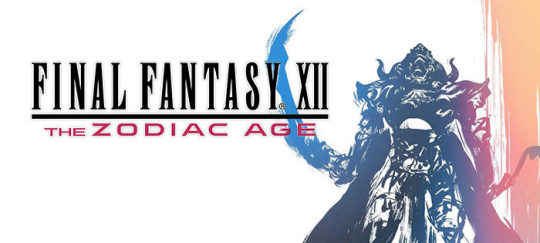
I played Final Fantasy XII, a bit, when it originally came out in 2006. I wasn’t playing games much in general at the time - as a junior in high school, it was the start of several years that lasted probably up until I graduated college where my experiences playing video games were few and far between. Still, the impact the Final Fantasy series had on me just a few years prior, when I put a thoroughly unhealthy amount of time into playing VII-X, roughly between the ages of 9 and 13, meant that I at least felt the need to check this new game out, as I have with every new single-player entry in the series. At the time, my reaction to it was even less enthused than my more recent reactions to XIII and XV, both of which I played for around 20 hours, essentially enjoying myself for that time, but being put off enough by their flaws to abandon them well before completion of a full playthrough. I probably didn’t even get past the first five hours of this game before giving up on it to retire to my room and listen to Pavement records and read anarchist literature, or whatever it was I was doing at that age.
I don’t remember many specifics as to why I quit so early, but upon returning to it over ten years later with the newly released Final Fantasy XII: The Zodiac Age for PS4, it’s not hard to imagine. This game is a thorough departure from what the series had been so far - battle is no longer a random JRPG-style menu clicking affair, but a more streamlined approach not too unlike MMOs of the time. Not only that, but the main way that battle is done is through the game’s innovative and weird Gambit system, which allows the player to essentially program characters to perform a number of actions in particular situations by assigning them simple if-then statements. When your gambits are set up correctly, the game practically - as a number of critics at the time complained - “plays itself.” Grinding through the overworld or a dungeon can sometimes literally be as simple as pointing your party leader in the right direction and letting your well-trained team take care of the rest. At the time, such a system must have felt like a removal of many of the things that made Final Fantasy what it was to me; looking at it now, I can’t help but admire the daring deviation in a series that, for whatever flaws it undoubtedly has, has proven itself to be consistently unafraid of twisting its formula in unique and bizarre ways.

My newfound appreciation for this overlooked series entry, however, is not just a result of time and distance. The Zodiac Age changes the way the game plays in a number of really quite significant ways. One of these changes is with its License Boards - the means by which the player spends earned experience to learn new abilities, use new weapons and armor, gain significant amounts of HP and helpful skills buffs, etc. Though I never played the original game enough to remember how these Boards originally looked, they’ve now been modified to lock each character into two “jobs” of the player’s choosing - one at the beginning of the game, and another a few hours into it. Again, my lack of experience with the original prevents me from true comparison, but considering how open-ended and overwhelming these job-based Boards can be, I’m happy to not have to deal with the truly open approach of the original.
A much more clear and obvious difference in this new addition is the inclusion of a dedicated fast forward button. Literally. At any point while not engaged in dialogue or the menu, the player can simply tap R1 to make the game play either twice or four times as fast as its normal speed. This seems like a bizarre option at first, one that I wasn’t particularly keen on utilizing in my first couple hours of gameplay: the characters move at a decidedly silly, Benny Hill-esque pace at these speeds, and when just getting acquainted with combat, actions happen at a rate too fast to properly comprehend. But I soon came to realize that for large sections of the game, double time feels like a perfectly natural pace to move in, considering the size of some of the maps in the game and the rather laborious pace of the normal speed. Some of the more labyrinthian sections of the game can take hours to fully explore - the final dungeon, for example, took me nearly five hours to get through at double speed, and while navigating my way through such a massive and rewarding space was possibly my favorite sequence of the game, I imagine that if it had taken me practically twice as long, it would have worn out its welcome long before I had finished it.
The Zodiac Age, of course, also sharpens and clarifies the graphics of the original in a pretty impressive way - it’s not that it doesn’t still essentially look like the PS2 game that it is so much that it accentuates the striking potential still being squeezed out of the aging console at the time of this game’s release, mere months before the launch of the PS3. Additionally, the entire gorgeous score has been re-recorded. Despite my initial misgivings about this game being the first FF I’m aware of to use a composer other than Nobuo Uematsu, Hitoshi Sakimoto wrote truly some of the most lovely and iconic video game music I’ve ever heard with this game, and to hear it expertly performed in high quality audio is something that never failed to propel me through the several dozen hours I spent with it.

Lastly, one of the more subtle, but very important additions of this new version is the inclusion of an autosave feature. Again, sometimes I’d go an hour or two in double time between save crystals, and it wasn’t unusual to occasionally die in that time: the game contains these enemies called “Elementals,” eerie floating orbs that look not unlike something out of the new season of Twin Peaks and can utterly devastate your party in the early hours of the game. With autosave, it was easy enough to simply start a couple minutes before I encountered said Elemental and do everything that I could to avoid it, but if I had been forced to go back an hour or more to the last save crystal, I likely would have set the controller down for good out of utter disgust for a game wasting my time like that in 2017.
All of this puts me in an interesting position, considering that the last review I wrote was for the Crash Bandicoot N. Sane Trilogy, in which I struggled to grasp the point of a remaster/remake deviating from its source in a way that fundamentally changes one’s experience of the game. There are a few obvious differences here. First of all, when it comes down to it, this is still technically the same game. The N. Sane Trilogy was a bizarre exercise in attempting to completely remake a game from the ground up in a new engine, while attempting to give it as much fidelity to the original as possible. In practice, though, lazy or insufficient design meant that the game just didn’t feel like the originals, despite its obvious visual similarities. The Zodiac Age, on the other hand, is a more traditional remaster, but with a whole lot more: the additions and modifications may change the game in significant and meaningful ways, but the core game is exactly as it always has been.
Probably even more importantly, these changes actually improve the game. Granted, my limited experience with the original means that any nostalgia or endearing feelings I have for it are mostly relegated to a general affinity for the series rather than specific memories of my first time playing it. This is as opposed to, say, Crash Bandicoot 2: Cortex Strikes Back, which I unequivocally played the shit out of as a kid. Still, the changes seem to stick to objective improvements: the ability to control the speed of play and the autosave feature make this game immeasurably more accessible to modern players, including those who, like myself, don’t necessarily want to devote the 60-80 hours of gameplay the original demanded in order to experience what the game has to offer. I imagine that even adventurous devotees of the original will be thrilled at an old favorite being given such a graphical and aural overhaul, not to mention the new play styles offered by the modified License Boards.

But all of these tweaks and improvements would mean little if, at the core, there weren’t already a great game worth revisiting here, and as a fan of this series, it’s a uniquely satisfying feeling to discover that this 11-year-old game is, indeed, great. While not exactly exempt of typical JRPG bullshit, it’s the strange, fascinating, and (relatively) mature game one would want out of a collaboration between Hiroyuki Ito (director of my two other favorite games in the series, FFVI and FFIX) and Hiroshi Minagawa (director of two other classics of the genre whose complexity precluded my appreciation at the time they came out: Final Fantasy Tactics and Vagrant Story; maybe it’s about time I revisit those as well).
It’s worth noting at the mention of Minagawa that this game’s setting of Ivalice puts it in the same world as his other games. The story, for as indebted as it is to Star Wars (and, unless I’m projecting, Game of Thrones, which is at the least interesting to note, given the exceptional pop culture phenomena that series has become since the show debuted five years after the release of this game), is engaging in its political intrigue and subtle character dynamics, especially compared to the melodramatic bombast of most of its PS2 JRPG peers, including Final Fantasy X. While all of these games, toward the end, are going to boil down to needing to save the world from some megalomaniacal evil and mystical jargon about crystals, and this game is no different, it at least boasts some of the best characters that have graced the series. Of particular note is the relationship between Balthier - think a demonstrably more suave Han Solo - and his partner Fran, a Viera (yeah, the sexy rabbit ladies) who has a mysterious connection to the magical Mist of the world. It’s hardly an original pairing - this game, as most games of its genre do, utilizes reductive archetypes - but through a combination of solid writing and particularly strong voice acting for the time, it just works.
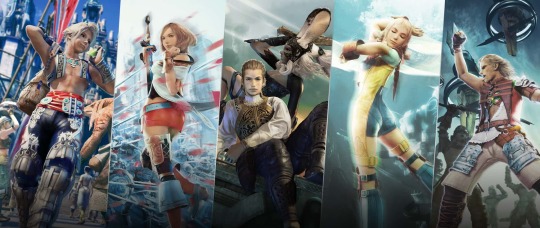
What also works, and works shockingly well, is the aforementioned Gambit system. Though conventional wisdom might suggest that reducing the actions needed to be taken by the player decreases the player’s engagement in the game, the opposite, as it turns out, seems to be be true in this case. In other Final Fantasy games, typical combat transports you to a different game screen where the player, more often than not, continually taps the action button to attack until all enemies are dead, a marginally fun exercise that can become mind-numbingly tedious upon repetition - and if there’s one thing you can expect in a game like this, it’s repetition. By keeping me on the map and allowing me to assign rote moves to characters to do themselves, the game actually kept me focus on the more fun aspects of these moments - the Diablo-esque satisfaction of filling out a map and collecting loot, the colorful character and enemy animations, and tweaking my Gambits to make sure that I really am doing all of this as efficiently as possible. Very few games make grinding as gratifying of an experience as Final Fantasy XII.
Of course, as abnormally gratifying as that grinding is, there’s still a lot of it, and even with the fast-forward feature, the game still takes quite a while to get through - my final time was right around 45 hours. This was with doing a good amount of the side content the game has to offer, including many of the optional monster hunts scattered throughout the world (while I declined to do several of the late-game hunts, I wholly admired this system, which drove me deeper into dungeons I had already explored, revealing whole levels that I never previously realized existed); still, I’d imagine a more straightforward playthrough would only shave that time off by a handful of hours.
Even I, under different circumstances, would have likely gotten bored with this if I hadn’t played it at the time that I did. This game happened to be released toward the beginning of the summer session at the school that I work at, where I’d typically work twelve-hour days throughout the week. As it turned out, after coming home exhausted and yet oddly wired every night, putting a couple hours into running around this vast JRPG world was exactly the kind of meditative release I needed to relax me before going to bed and doing it all over again. I can pretty definitively say this game helped me survive the most stressful time of my work year, and as a result, I’m all the more happy I never discovered this game’s idiosyncratic charms until now. Now I do have a well of good memories associated with a particular time and place wrapped up in this game, and I have a new top-tier favorite in a series I will never be able to help but love.
8.5/10

#Final Fantasy XII#Final Fantasy XII: The Zodiac Age#Square Enix#JRPG#Video Games#Games#PS2#PS4#retro#review#criticism#pop culture
0 notes
Text
The Crash Bandicoot N. Sane Trilogy is a (fun) shallow novelty

In a recent Time interview, Sony Europe Exec Jim Ryan argued against the concept of backwards compatibility à la Xbox as a viable business plan, positing that for as many people that ask for it, very few actually take advantage of it. “That,” he said, “and I was at a Gran Turismo event recently where they had PS1, PS2, PS3 and PS4 games, and the PS1 and the PS2 games, they looked ancient, like why would anybody play this?” His statements may reflect the actual opinions of a certain segment of the gaming community, but they also come off as shortsighted and just kinda...dumb. He’s (first of all) bashing products once made by his own company, which for pure business reasons sounds some alarms. But more than that, he’s making an argument against the durability of games, asserting that unlike other forms of art, they have an expiration date, largely connected to the visual style allowed by the hardware limitations of the time they were made in.
While the Activision-produced Crash Bandicoot N. Sane Trilogy is removed from Sony’s legal grasp, to a degree, this ground-up remake of the classic O.G. Playstation platformer series is in line with Ryan’s realm of thinking. This isn’t a “remaster” in the way that most games that bear that designation are, no mere cleaning-up and up-resing to make those chunky 90’s polygons tolerable on modern TVs, though perhaps it should have been. Rather, this is more a Gus Van Sant’s-Psycho-kind of shot-for-shot recreation of the original games in a brand new engine, and the good news for the Jim Ryans of the world is that it looks great. Fans of the original trilogy such as myself, whose ravenous nostalgia for all things pre-aughts knows no bounds, will undoubtedly spend the first few minutes of this game in slack-jawed awe at their childhood game rendered in all its colorful, rounded, shiny 2017 glory.

Some of that awe may go away, however, once those players get to, say, the second level of any one of the three games packaged, and start dying. Players at this point might have one of two reactions - “Shit, I forgot how hard this game was,” or “Shit, I don’t remember this game being so hard.” Both of these reactions are valid. The original Crash Bandicoot games, once you got past the rollicking soundtrack and vaguely-creepy but mostly-cute anthropomorphisms, were occasionally grueling obstacle courses fraught with trial-and-error frustrations. They were awkward 3D platformers that had trouble grappling with the idea of what a 3D platformer could even be, requiring the precision controls of 2D genre classics like Mario but in practice, controlling in the stiff, wonky way many games of the 32-bit era did. Even if this was a straight remaster of the original games, many players may have found themselves running sideways off a straight platform because of the bafflingly 3D controls in ostensibly 2D sections only so many times before they became a little disillusioned at how unflatteringly these games have aged. Naughty Dog may have gone on to be one of video game’s greatest and most celebrated developers, but it took a while to reach that peak.
But there’s more to it than that. Sure, on the surface level, everything pretty much looks the same - Crash (or, in a welcome addition to these versions, his sister Coco) jumps, spins, slides and bodyslams his way through the same exact levels with the same exact enemy and box locations that he always has. But upon mere days of the N. Sane Trilogy’s release, many articles and blogs ran about the ways the new game’s engine failed to fully replicate the physics and mechanics of the originals. Now the developers at Vicarious Visions themselves have confirmed these departures, the two most egregious of which are faster falling animations and pill-shaped collision boxes - meaning that many would-be close-call landings of the original games are now perplexing misses of the new games. As someone with the physics of the original games ingrained into my muscle memory, this deviation was particularly hard to accept for me; it wasn’t until probably ⅔ of the way through Cortex Strikes Back that I felt I may have finally mastered these new mechanics, just in time for the most hand-wringingly, hair-pullingly stressful levels of the game.

One can only wrestle with this kind of no-cigar approximation for so long before one starts questioning what the point is. Why remake these games in this way? Most players of the original games will be put off by the subtle-but-ever-present gameplay changes, while newcomers will likely be nonplussed by games that, graphical overhauls and Unity-based physics changes aside, still feel stuck in gaming’s awkward pre-teen phase. The answer, unfortunately, is probably financial. An HD remake of a nostalgic favorite among a certain generation of gamer is an easy cash-grab - $40 seems like a reasonable enough price for three whole games that have been completely made over from scratch, and even if the details of the way the games play start to grate on players, most will presumably still get what they wanted from the experience, a quick and shallow indulgence in nostalgia with little critical considerations. Truly replicating the original in every way likely would have been a costlier endeavor than deemed necessary for the kind of experience this was meant to be. The apparent success of this release has even sparked conversations about giving other PS1 classics, such as Spyro the Dragon, a similar treatment.
All of this complicates the question set out at the beginning of this review, about the aging process of video games, graphically, mechanically, or otherwise. I will always assert that no such expiration date exists. Developers of console generations long past were limited by the technology they were working with, but that doesn’t mean the art they made wasn’t intentional and worth celebrating. The early 3D era, both in play and look, may have not aged as gracefully as the late 2D era that preceded it, but the blocky, fuzzy-textured art of Crash Bandicoot and other games of its era will always hold a strange sort of appeal to me, and not entirely for nostalgic reasons. This was an era of radical, thorny change, full of potential both realized and missed by developers who had no clue what they were doing, but did it anyway, in a brand new dimension. Exploring the games of this time can be both exhilarating and slightly embarrassing, but rarely boring.
That’s all to say that the Crash Bandicoot N Sane Trilogy really never had to happen. A remaster would have been nice, and I will never argue for anything less than the total preservation and accessibility of video game history, but to gloss over the style seems to me the creation of a wholly different thing, just as it would if one were to modernize the English in an old piece of literature. This kind of remake feels like little more than a shallow novelty. It’s a fun shallow novelty, for sure. Despite whatever complaints I maintain about its mechanics, I still played it enough to 100% Cortex Strikes Back and enjoy a considerable amount of the other two games. In returning to them, I still felt the same itch to smash every box, collect every gem, and even give those speed runs a shot. Pulling off a difficult clusterfuck of obstacles unscathed in the later levels is still as exhilarating as ever, and breezing through the early ones is still as satisfying. I expect that others will appreciate it equally. But a shallow novelty it remains. Thankfully, though, the game prepared me to expect little more, so at least it’s not a disappointing shallow novelty.
6.3/10
#Crash Bandicoot N Sane Trilogy#Crash Bandicoot#Games#Video Games#Criticism#PS1#Playstation#Sony#Retro Games
2 notes
·
View notes
Text
Emily Ruskovich’s Idaho sweeps the corners of time and place in a powerful tale of redemption

I run the reading club at the school I work at, and the last book we read was Kurt Vonnegut’s classic WWII-by-way-of-fourth-dimensional-aliens novel, Slaughterhouse Five. Rereading this book for the third or so time, what struck me was not the mere wacky daringness of its frequent jumps back and forth in time, but the appropriateness of those time jumps in a book that was ostensibly written to stare death, in the form of the Dresden bombing, in the eyes. The Tralfamadorians, the aliens in question, can see all moments happening at once. In some moments, characters are alive and well, in some, they are dead. So it goes. The protagonist of the book, Billy Pilgrim, takes great comfort in this concept of time, not as the unmovable push forward that we third-dimensional beings with our limited perception see it, but as a series of permanent moments whose order does not particularly matter. If someone was alive, and happy, in a moment, they will always be alive, and happy, in that moment.
Emily Ruskovich’s debut novel, Idaho, is a grounded, naturalistic work of near-poetry, not a meta-heavy sci-fi history, but like Slaughterhouse Five, the center around which it circles is a moment of senseless tragedy, of inexplicable violence. One evening in 1995, a girl is killed, and her sister disappears. Much of the novel is centered around its main character, Ann, trying to solve the mystery of what happened that night, pulling bits and pieces from her husband, Wade, the father of these girls. She knew Wade a bit before the tragedy, but she married him afterward, and much of her search is motivated her attempt to keep the failing memories of her husband whole as he slips further and further away into early-onset dementia. It’s a rather humorless work, and more than a little somber, but surprisingly enjoyable, grounded by a tremendous, idiosyncratic sense of place and a restorative faith in human compassion, love, sacrifice, and forgiveness.

Like Vonnegut’s opus, Idaho likes to jump around in time, dancing around the tragedy that underpins it but never quite daring to fully delve into the moment itself. I’ve always felt that Vonnegut’s - and now Ruskovich’s - reason for this was that such an act of meaningless violence defies explanation or anything that can be understood through narrative. To do so would be to dive into nihilism, something both of these works are far too in love with life to do. In some moments of this book, the girls, May and June, are alive - maybe dealing with personal grief or heartbreak, but our knowing what fate soon will befall them makes these problems smaller, more quaint, even endearing, as they’re founded in growing pains that resonate as relatable just as much as they do personal and unique. In some moments, they haven’t even been born yet, as the young Wade and their mother, Jenny, meet and try to establish a life for themselves in the harsh mountainous outskirts of a small Idaho town. In many, they’re long dead, as Ann tries to hold her husband and his past together and Jenny serves a life sentence in a rural prison for a temporary moment of unexplained insanity. But even if these characters have to live the burden of the lifelong aftermath of an unforgettable tragedy, we’re given a bigger perspective, being able to return to a simpler, more youthful and vibrant time a mere chapter later.
It’s this perspective that keeps this novel from being brilliantly belabored but difficult to read, and instead makes it a lovely, poetic evocation of character and place that I yearn to return to in the future. Even the hardest of subjects that this novel touches, such as domestic abuse, are informed by a startling capacity for empathy, dedication, and forgiveness that miraculously manages to avoid coming off as overly reductive or apologetic. This is thanks largely not just to the strength of Ruskovich’s characters, but of her beautiful prose, in all its tenderness, inventiveness, and dexterity. With her words, abstract concepts get transposed through character’s actions, through nature, through art, through multiple perspectives, connecting lives and locations in ways both profound and endlessly interpretable.
It’s to Idaho’s benefit that it keeps many of its most central and essential moments and motifs obscured in mystery, highlighting the limits of human understanding and the various ways in which we compensate for those limits. What deficiencies this may leave in a clean narrative it more than makes up for through the redemptive personal arcs that it makes its chief concern. This is a story not about loss and guilt, but how we deal with it, and one that makes a refreshingly hopeful case for recovery, while not shying away from the cruelty and darkness that makes that recovery so impactful. Unlike Billy Pilgrim, the characters of this story don’t have the ability to move back and forth through time, but the narrator does, and therefore we do, and the symbiotic relationship we build with these characters through miscellaneous moments of their lives feels like the key to this eventual redemption.
9.2/10
0 notes
Text
RTJ3, Motherfuckers

The election of Donald Trump as President of the United States in November came as a shock to sheltered white liberals who could’ve sworn that our country had moved past it’s fascist, racist, sexist past. But Killer Mike already experienced a big disappointment earlier in the year when his buddy, the immortal Bernie Sanders, lost his campaign to under-reporting and DNC fuckery. Likewise, El-P’s verses have never not sounded like they were incoming transmissions from some dystopian future. In short, it feels like this was the moment these guys have been bracing themselves for since they first teamed up. So while many Americans sat stunned at finally realizing the rampant criminality inherent in domestic politics and business, Run the Jewels put the finishing touches on their third and best album yet, the unsurprisingly titled Run the Jewels 3. In the months following the election, concerned Americans have finally mobilized into groups large enough to do something, with the realization of what must be done when the government no longer represents the will of the people. In the week since Trump’s inauguration, this mobilization has reached historic numbers in resistance to the President’s tyrannical executive orders and Republican’s attempts to dismantle the few supports the country maintained as an attempt to give a bit of equality to its stratified class system. And RTJ3 has graciously provided the soundtrack to this resistance.
Weighing in at 14 songs in 52 minutes, RTJ3 is the group’s longest and heftiest record yet, and it’s all the better for it. Run the Jewels 2 was my favorite album of 2014 largely for the visceral thrill that the majority of that record provided - it was a masterpiece of righteous shittalking and creatively bragadocious hyperbole that left practically no room for either rapper, let alone the listener, to take a breath. This album proudly carries on that mission (often explicitly - “You’re running out of ways to go fuck yourself; I will innovate” El-P offers on “Oh Mama”) while at the same time opening it up to nuance that the duo has never showed time for in the past. The first few songs are perfect examples of this, as “Down” opens the album in an uncharacteristically low-key way - low-key for the typically vicious duo, anyway, as the the track still simmers with barely contained existential rage, but keeps it under wraps enough to provide a newfound focus on melodicism and depth of production. El-P’s tracks in the past have often intentionally felt like blunt weapons in the form of blown-out bass buzzes, and the lush synth orchestration here feels like a welcome evolution of the sounds the group is capable of making while barely mitigating the fury at the heart of their power.

That fury eventually gets unleashed, but even then the production remains thoughtful and detailed. On “Talk to Me,” the beat cuts out for an entire half of El’s verse as a distorted guitar wail builds on one side, eventually reaching critical mass as the beat crushes back down. On “Call Ticketron,” a pulsating synth loops remains just barely contained enough to be danceable, meeting its antithesis in the verse and they combine to impossibly echo Young MC’s “Bust a Move.” Towards the end of “Thursday in the Danger Room,” Kamasi Washington’s sax solo blends gorgeously into the tender melody in a way that would have seemed entirely out of El’s production wheelhouse back in the beginning of RTJ’s run.
The raw emotion the duo shows on that track also comes as a surprise given their previous output, as El-P opens up with unprecedented vulnerability about his conflicted feelings during the process of his friend Camu Tao’s death, and Mike recounts a story of senseless violence. Considering that their first collaboration came in the form of their consecutively released solo albums, both of which were produced entirely by El-P and contained a pretty serious blend of personal and political subject matter, it’s almost easy to forget that the first proper Run the Jewels album was mostly just a badass, fun exercise in the art of the hype track. While there were some very standout political and personal moments on RTJ2 that solidified the group’s reputation as the best punk band that really wasn’t at all a punk band, it still felt fairly well grounded in the almost breezily ferocious style of their first record. So it actually somehow feels like both an earned progression and a refreshing return to form that this album is their deepest dive into introspective and sensitive lyrical territory yet.

Of course, that comes with no shortage of the absurdist excursions into the equally hilarious and horrifying boasts that the duo’s made their signature. Throughout the course of the album, moms get kidnapped during jazzercise, innocent animals get threatened, and scrotums get speed bagged, all for the look on their enemies faces, if there’s a single person left who isn’t in love with these dudes. The chorus on “Panther Like a Panther (Miracle Mix)” repeats “I’m the shit, bitch,” just in case their thoughts about themselves weren’t quite clear enough.
But the best tracks are the ones that combine this formal mastery with heart-on-sleeve pathos that the group is becoming increasingly willing to indulge in. “Thieves! (Screamed the Ghost)” opens with a Twilight Zone sample and ends with MLK’s declaration that “A riot is the language of the unheard,” perfectly encapsulating the headspace of both RTJ and the nation as the lyrics identify the violence that leads to violent acts. “Hey Kids (Bumaye)” blurs the line between party and riot, especially when Danny Brown’s verse kicks in. And “A Report to the Shareholders/Kill Your Masters” might be the best track RTJ has made yet, a song in which Mike and El simultaneously mourn for and issue a call to arms for a coming civil war. They save the final verse for Zach de la Rocha, who mirrors the dystopian sci-fi and jazz he invoked with “Close Your Eyes (And Count to Fuck),” trading Blade Runner for Children of Men and Miles Davis for Charles Mingus, all the while giving perhaps the most rousing power-to-the-people declaration he’s mustered in his entire career as he seethes with threatening sincerity. The last seconds of the track end with Mike’s entreaty to kill your masters, an official proclamation for revolution that stands as one of the most mobilizing moments in music I’ve ever heard.
10/10
#Run the Jewels#El-P#Killer Mike#Bernie Sanders#Donald Trump#MLK#Danny Brown#Zach de la Rocha#Hip-Hop#Music#Rap#Review
1 note
·
View note
Text
In Blake Crouch’s Dark Matter, George Bailey meets Schrodinger’s Cat

The main conceit that forms much of the plot of Blake Crouch’s Dark Matter is the idea in quantum mechanics that for every observable action or decision, at least two realities form as separate universes in which that action or decision plays out differently. The Wayward Pines author uses the oft-quoted Schrodinger’s Cat scenario for the millionth time in pop culture to explain this concept, but the character drama that plays out through this novel is so concise and simple that I’d suggest simply reciting its major plot points over killing the poor cat again the next time a layperson needs an easy explanation of the many-worlds theory. Crouch breaks it down into the most relatable terms possible - for every major decision or event in your life exists a reality where it went the opposite direction, in addition to countless other realities in which much less significant decisions and events plays out in infinitesimally different ways.
For Jason Dessen, our protagonist, that major life decision comes down to one thing - after his girlfriend got pregnant, they decided to stay together, and to have the baby. He gave up a chance at his promising career as a potentially brilliant quantum physicist for a more humble teaching job, but 15 years later, he and his wife, Daniela, are still together, happily living a normal life with their teenaged son. Still, as essentially content as he is, Jason can’t help but wonder what his life might have been like had he focused on his career instead. Cue a mysterious stranger that invades his life less than 20 pages in and forces him into a world where that hypothetical is a reality, and it turns out, the grass is decidedly less green on this side.
At its broadest, the plot of Dark Matter is painfully obvious and clearly autobiographical, an unabashedly transparent work by a husband and father who may just about be approaching the age where the term “mid-life crisis” starts getting tossed around. This It’s A Wonderful Life-by-way-of-Doctor Who plays out as both an opportunity to fantasize about the “what-if’s” in life as well as a self-affirmation that the path our protagonist chose in the first place was unquestionably the best one he possibly could have. Again, broadly speaking, it’s a perfectly predictable story, one that I felt thoroughly underwhelmed by in the early set up.
But once the story gets rolling, it moves, and though the very end of the book may not feel like a huge departure from what you’ve been expecting all along, every step that Crouch takes towards that ending feels inspired, surprising, and thrilling. Through the multiple phases of its lightspeed plot, the stakes get exponentially raised in brilliantly wacky ways. The implications of a piece of technology that allows for interuniversal travel are thoroughly thought out, and brought to extremes that somehow never lose the essential thread of the story. While the first half of the book turns into a kind of life-swap cat-and-mouse thriller, and finds surprising success with it, the second half reaches Rick and Morty levels of high concept sci-fi absurdity, guided and grounded masterfully by Crouch’s nearly minimalistic prose.
Ultimately, the familiarity of the setup ends up being an asset, allowing Crouch to riff on and fuck with the formula the way that Thelonius Monk, an apparent favorite of Jason Dessen’s, might do an old standard. He approaches it with an urgent energy and a genuine excitement for the possibilities inherent in such a story, as well as adding a grounded personal touch. Though the pathos that came from this rarely affected me as much as may have been intended, the tight pacing and virtuosic plotting made it viscerally exhilarating and well worth the inevitable pitfalls of such well-tread territory.
8.1/10
0 notes
Text
Let It Die is cool, but it’s also cold
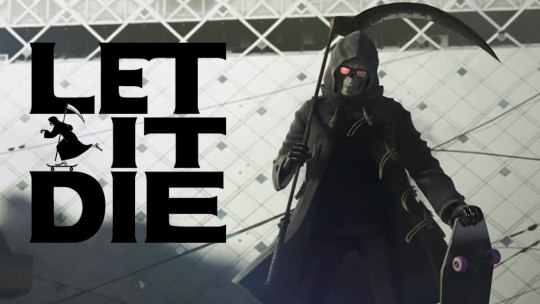
It’s hard not to look at Let It Die as some sort of gauge on the viability of the free-to-play model on the greater video game landscape. While the model has obviously had a lot of success within the realm of mobile games, and even quite a few high profile, big-budget PC games have adopted it after failing to meet their profit goals the old fashioned way, Let It Die still feels like something of an anomaly in the category at large. It’s the newest game by one of the mediums’ few unequivocal auteurs, Suda51, and his company, Grasshopper Manufacture, and as such, has a sense of gravity to the expectations of quality and artistry that few other free-to-play games have to contend with.
The microtransaction-heavy model has long been criticized as a just kinda generally shitty business tactic, but in today’s gaming landscape, where even $60 AAA games no longer even have to pretend to be shameful about milking extra dollars out of players hungry for extra skins or blind boxes, making a game that charges you nothing to start it almost even sounds generous. Thus, Let It Die feels like it’s arriving at exactly the right time, a relatively higher-tier developer embracing and, theoretically, elevating the gaming model at a time where the fluctuating status quo would only require one great game to change hearts and minds. Unfortunately, despite the surprising degree of success that the game has seen in the last month or so since its release, Let It Die just isn’t a great game. While it’s overflowing with the wacky and undeniably cool style that Suda51 has been perfecting throughout his career, the core gameplay elements largely left me feeling empty, and reinforced for me the inherent pitfalls of free-to-play gaming.

The beautifully detailed picture that the player sees when she first start up the game is the Tower of Barbs, a monstrous overgrowth of 40 hellish levels erupting from the remains of the orphaned island that used to be South Western Tokyo. It’s a powerfully rendered image that pairs immaculately with the glitchy 8-bit style embraced in the menu screens. By the time Uncle Death, a grim reaper wearing 3D glasses, came riding his skateboard in and addressed me as “Senpai,” I was ready to go wherever this game took me. One of the most frustrating things about the game is that as much as the gameplay pushed me away, the sheer style of it remained omnipresent, urging me to stay in that world. Every floor of the tower seems to get more fucked-up looking as you go, rewarding progression with a new, weird, environment until that one gets stale. Every enemy explodes in a high-pressured geyser of gore upon death in their own slightly unique way, and it’s morbidly satisfying, especially after a particularly harrowing encounter.
Every trip to the waiting room of the tower or The Hater Arcade promises some intriguing interaction with one of the surprisingly compellingly rendered characters. There’s the Mushroom Magistrate, whose vocal performance by Isabelle Fuhrman does a pretty good job of convincing one she really has gone insane from too much mushroom consumption. Naomi Detox, the teenage arcade attendant, never fails to find new, creative ways to complain about her loser boyfriend between assigning you new quests. Meigin actually has some pretty useful tips for bettering your performance, as long as you can get past his uber-gamer elitism. If you care to shell out real money to take the express elevator, the operator, Rin Torai, will share some delightfully awkward rides with you. None of these characters are much more than the one-note characterizations they seem to be; as far as I’m aware, there are no actual plot arcs or anything involving them. Regardless, they play their roles well, and serve to color the world of the game in with some remarkable personality.

If I were only grading this game based on its aesthetic impact, it would be a lot more glowing, but unfortunately, there’s also an actual game here, and I have a lot fewer nice things to say about that. The gameplay of Let It Die has rightfully earned some comparisons to Dark Souls, with its challenging, timed-swing focused melee combat and moveset-containing weapons, not to mention the amount of time between “checkpoints.” These comparisons do the game no favors, though, as these are all difficult mechanics to pull off in a game without making it unnecessarily frustrating, and while Let It Die might do better than some other Dark Souls clones, it still fails to meet that standard of engaging the player rather than pushing her away with its systems.
Combat takes both skill and practice to get good at, and while getting good certainly is a possibility in this game, it’s not nearly as rewarding as I would have liked it to be. There is little weight to most of the weapons in the game. While in Dark Souls, learning how to properly use any given weapon is a matter of spending enough time with it to memorize its moves, there is just a certain feel that you get from it as well, something that comes off as intuition but is really a combination of the careful animation of your character and the tight controls that provides instant feedback on your performance. That feedback is practically nonexistent in this game. Each attack animation feels generic and unintuitive, leaving you with nothing but sheer memorization of the amount of time an attack takes and what weapons are preferable for which enemy. It’s not just boring, it’s straight-up repellant in the early hours of the game.
Going along with the Dark Souls comparisons, this game has a similar lack of a pause button and long stretches of levels to cover before the player can return to their main hub, in this case, an elevator that you can ride down to the waiting room in order to level up, buy necessary upgrades and equipment, chat with characters, or maybe even just stop playing (quitting mid-level is considered a death). Again, while Dark Souls will use this mechanic in combination with clever level design in order to add to the level of dread and immersion, Let it Die’s levels feel practically procedurally generated, a random series of halls and rooms with repetitious textures and lazily placed enemies, and the feeling that builds as one traverses these maps is less dread as much as just tedium. The relief that I’d feel as I’d spot an elevator in the distance had little sense of accomplishment mixed in with it; mostly I was just happy that now I could stop.
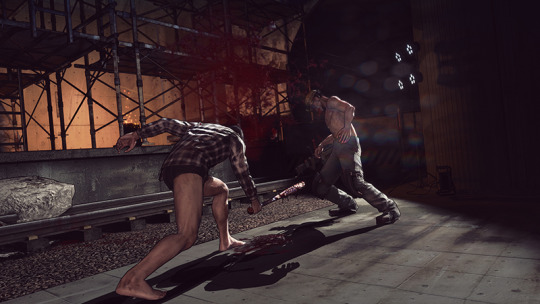
As relatively “fair” as one-on-one combat can feel, I never really found a way to successfully take on two or three enemies. Oftentimes I’d find myself stuck in an enclosed room with little environmental factors to kite and isolate enemies with, and the second I’d try to put in a single attack, I’d get pounced on. In short, these encounters feel basically designed to kill you, and that’s where the insidious free-to-play factor comes in. When you die, you have a couple options. You can follow the advice that the title of the game seems to be giving you and simply let your character die - they’ll be reborn as a “hater,” an especially tough enemy that another character can face off against if you return to that spot, and if you defeat them, can be sent out to raid other player’s games (the game has some fairly extensive online features that I never really touched, so I’ll say little about them in this review).
Your other option upon death is given to you by the helpful insurance saleswoman who greets you upon each death - to revive yourself with a death metal, a form of currency in the game that is very nearly only earned by purchasing packs with real money. In effect, this is essentially the equivalent of putting another coin in the arcade machine, an apt mechanic given the game’s framing device. This is really what you’re more likely to want to do, as it takes time to level up your characters, and having a well of available, trained fighters becomes more and more important as you progress through the tower. And I’d almost feel tempted to forgive this if some of the encounters felt a little bit more doable, but as it is, death seems essentially unavoidable. It feels like a rote exercise, that rather than defeating enemies through sheer skill or adequate leveling, you simply pay to bring your health back up and start back right where you left off; it eliminates the challenge and the reward possible in these encounters, and any time the “risk” side of a risk/reward situation is actual money, it’s going to be pretty hard to convince me to go for that risk.
To the game’s credit, it manages to work its style even into these microtransactions, such as the express elevator, that actually is much nicer looking than the regular elevator, making one feel like she paid for first class. That it treats such a potentially damning game mechanic with a nod and a wink is legitimately funny, and surprisingly tempting, but the lack of fun I was having with the rest of the game convinced me against it. This was essentially the main problem I encountered throughout the game: wanting to like it so much more than I did because of the style but finding myself unable due to the lack of substance. And the style really is nothing to gloss over: Suda51’s artistic success has largely been defined by the aesthetics of excess, and the way that this game manages to balance its stylistic gratuitousness with something approaching tastefulness is an oxymoron that’s a wonder to behold. If only it felt as inspiring to play as it does to look at.
5.4/10
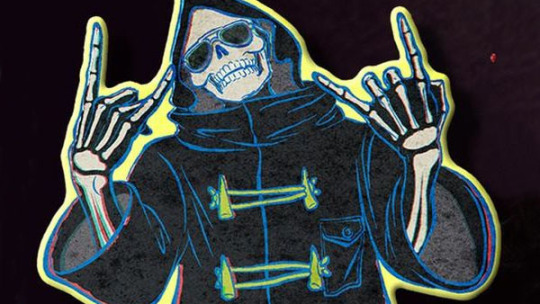
2 notes
·
View notes
Text
We’re only eight days into January, and David Bowie has already dropped one of the best albums of the year

Are there any living and working musicians in rock/pop music as legendary as David Bowie? One could perhaps argue that there’s Paul McCartney, but for most alternative music nerds such as myself, he wouldn’t even get close to matching the influence and power that Bowie holds. But it’s worthwhile making the comparison anyway, because McCartney represents the ultimate elder statesman of rock music, content to please nostalgic crowds with the classics ad infinitum for the rest of his days. While Bowie’s been around only slightly fewer years, he’s proved himself to be a much more prickly and picky character in the decades since the height of his success. He may not ever regain the critical and commercial spotlight he once held in the 70’s, but if he gives a single fuck, he certainly hasn’t shown it. The reinvention and progression that has been a part of his aesthetic from the very beginning has never gone away, and he’s remained dedicated to forging bold new paths through his entire career.
Bowie’s newest album, Blackstar, is no exception to this, though it’s also proof that making fresh new music doesn’t require a rejection of the past. The sound of this album combines the improvisational solos and crescendos of jazz with the tightly wound rhythms and arrangements of krautrock, mining the various styles that defined both Bowie in his heyday and his contemporaries at the time. But despite the vaguely retro aesthetic, this album is unmistakably, brilliantly Bowie in 2015, thanks nearly entirely to his vocal performance.
He sounds more vitalic and inspired than he ever has as his distinctive voice sits uncomfortably but rightly above the moody instrumentation. “I’ve got nothing left to lose,” the 69-year-old proclaims on “Lazarus,” and it sounds like it. While Bowie’s voice has always been somewhat extraterrestrial in effect, here he sounds more grounded and human than ever, but this fighting spirit mixed with his daring artistic experimentalism makes him sound all the more enigmatic. He’s as gripping and mesmerizing as he is mobilizing and inspiring, and he adds the essential voice to what would already be a stunning instrumental album.
And that instrumentation really does deserve to be highlighted here. Outside of Bowie himself, the most distinctive sounds throughout the album are Mark Guiliana’s drums and Donny McCaslin’s saxophone, which sound incredible on their own, but mix together in an organic synergy that can rarely be found outside of jazz. On “Blackstar,” “Tis A Pity She Was a Whore,” and “Sue (Or In A Season of Crime,” Guiliana builds an intricate rhythmic intensity that feels equal parts post-punk and bebop, while McCaslin interjects between verses with avant-garde stylings that conduct the consistent, even repetitive beats into climatic builds and restrained falls with masterful subtlety.
This dynamic leads the way for more instrumental layers: new guitar and flute lines will pop up three-fourths of the way through an already hefty song, adding sounds upons gorgeous sounds until the songs purposefully collapse under their own weight. Late-game chords changes will perfectly mix sweet and sour, recalling melodies that were forgotten earlier in the song but in fundamentally different ways. One particular highlight is the distorted bassline that pops up just after the three minute mark of “Sue (Or In a Season of Crime),” which hits a sudden almost Lightning Bolt-esque intensity before dissipating almost immediately, then comes back in the final moments of the song in a dramatic climax.
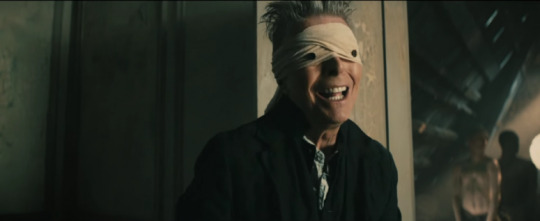
Some of the album’s best moments come when Bowie’s voice and the instrumentals temporarily combine into one. His grunts and screams at the end of “Tis A Pity She Was a Whore” are a perfect counterpoint to the wailing sax chaos, for example. A harshly distorted guitar seems to be responding angrily to the lines he delivers throughout “Lazarus.” And “Girl Loves Me” is easily his most distinctive vocal performance: “Where the fuck did the Monday go?” he asks repeatedly, his voice rising to comical peaks towards the end of every sentence and reverberating alarmingly. He seems to shake and rattle the whole track. In the middle of the song he repeats the question until his voice and the rhythm underpinning it are overtaken by synth strings and squealing noise, then everything snaps back into place, bending and twisting dizzyingly towards the outro.
Then there’s the final two tracks. “Dollar Days” breaks away from the rhythmic intensity of everything that came before it, the drums taking a back seat for once to strumming of guitars and an increased focus on melody. Despite the relative relaxation this track offers, the lines Bowie delivers here most explicitly reference the unflinching and determined energy he’s regained recently: “If I never see the English evergreens I’m running to, it’s nothing to me,” he claims, fully aware that he’s of an age where most have settled into a quiet retirement, but rejecting this proposition fully in the face of all the work he has left to do. The best track on the album, “I Can’t Give Everything Away,” is the most sonically reminiscent of Bowie’s past. The drum machine that leads into the song and the harmonica that kicks in shortly after specifically remind me of “A New Career In a New Town,” while the droning synths recall the latter half of the album that song is on, Low, which remains Bowie’s greatest achievement. It’s a masterclass in returning to the past without indulging in empty nostalgia.
Through the time I’ve spent with this album, I was surprised to keep being reminded of an artist I’ve never once associated with David Bowie: Swans’ Michael Gira. Like Gira, Bowie is an artist who’s been working for decades and has come back from a long hiatus, and like him, he did so with a solid but safe album (Bowie’s The Next Day, Swans’ My Father Will Guide Me up a Rope to the Sky). But in this analogy, Blackstar is Swans’ 2012 masterpiece The Seer, a brilliantly vital and defiantly experimental album to come long after the supposed glory days of that artist which redefines him for a new generation by taking life-long artistic obsessions and distilling them in a fresh, confident, and artistically pure expression. If this is the dawn of a new era of Bowie, then I will stand by with giddy anticipation for what he will do next. But even if this is it, Blackstar is a hell of an album, the first one he’s made in ages that can sit proudly next to the most noteworthy excerpts of his discography as a defining work of one of the most legendary figures of rock music.
4.5/5
#david bowie#blackstar#music#new music#criticism#review#swans#jazz#post-punk#krautrock#lazarus#pop culture#pop#indie rock#rock
3 notes
·
View notes